Intercultural Communication Apprehension Scale
VerifiedAdded on 2020/05/28
|31
|6871
|45
AI Summary
This assignment deals with assessing Intercultural Communication Apprehension (CA) using the PRICA scale. Students are instructed to complete the provided PRICA scale questionnaire, which consists of 14 statements about interacting with people from different cultures. After completing the scale, students will calculate their PRICA score based on the provided formula and interpret their results based on the scoring guidelines. The assignment emphasizes understanding one's level of intercultural CA and its potential impact on communication.
Contribute Materials
Your contribution can guide someone’s learning journey. Share your
documents today.
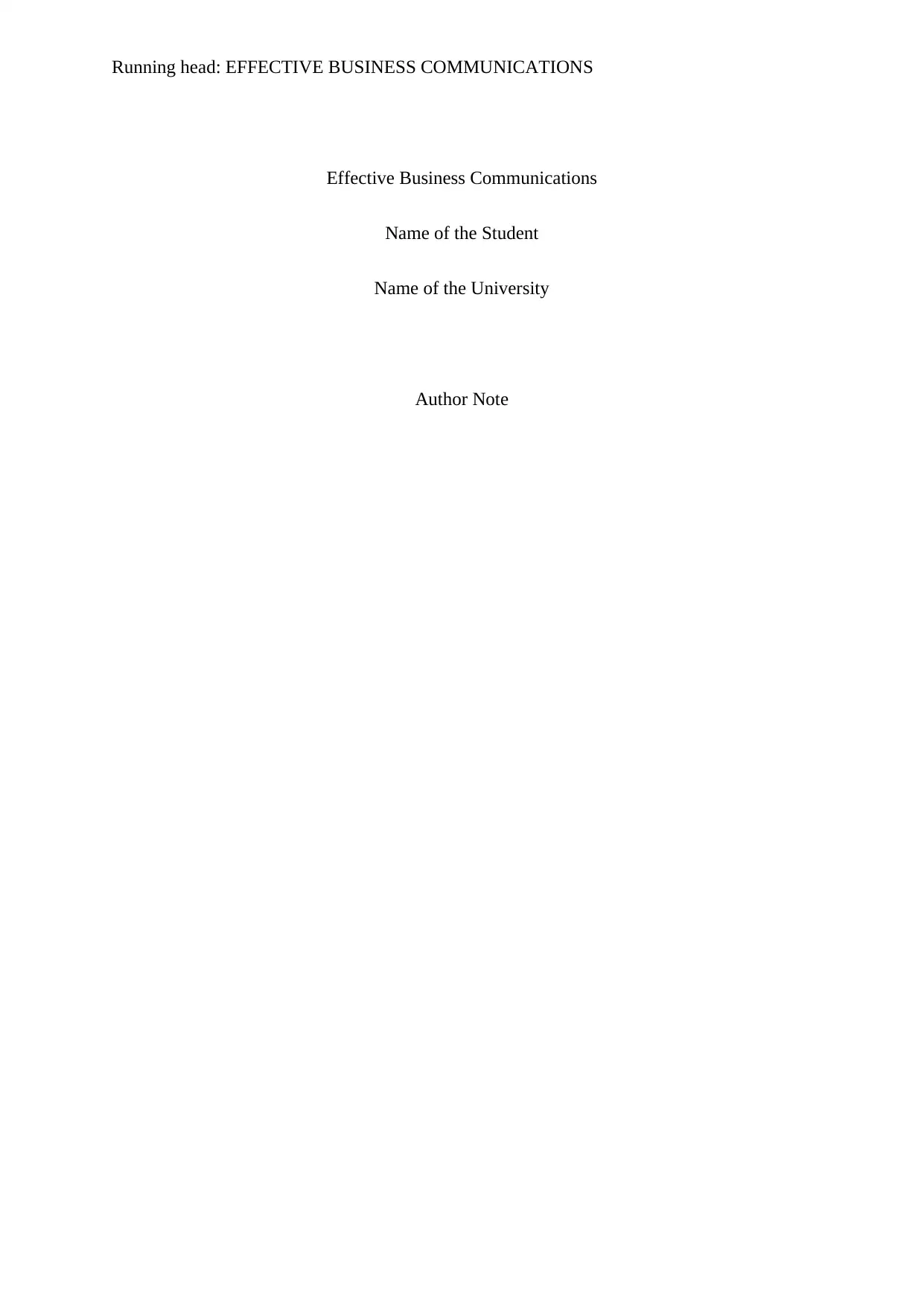
Running head: EFFECTIVE BUSINESS COMMUNICATIONS
Effective Business Communications
Name of the Student
Name of the University
Author Note
Effective Business Communications
Name of the Student
Name of the University
Author Note
Secure Best Marks with AI Grader
Need help grading? Try our AI Grader for instant feedback on your assignments.
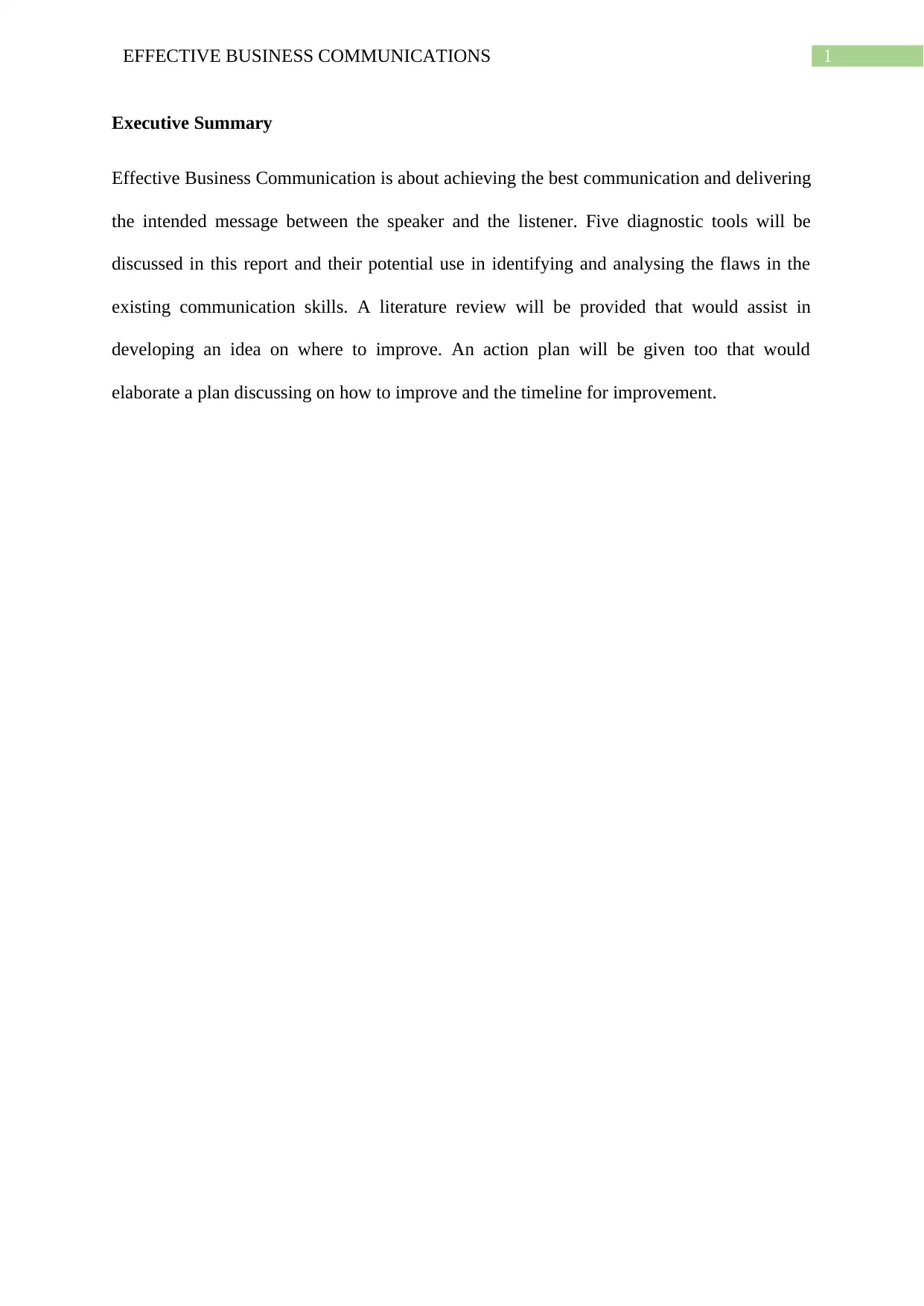
1EFFECTIVE BUSINESS COMMUNICATIONS
Executive Summary
Effective Business Communication is about achieving the best communication and delivering
the intended message between the speaker and the listener. Five diagnostic tools will be
discussed in this report and their potential use in identifying and analysing the flaws in the
existing communication skills. A literature review will be provided that would assist in
developing an idea on where to improve. An action plan will be given too that would
elaborate a plan discussing on how to improve and the timeline for improvement.
Executive Summary
Effective Business Communication is about achieving the best communication and delivering
the intended message between the speaker and the listener. Five diagnostic tools will be
discussed in this report and their potential use in identifying and analysing the flaws in the
existing communication skills. A literature review will be provided that would assist in
developing an idea on where to improve. An action plan will be given too that would
elaborate a plan discussing on how to improve and the timeline for improvement.
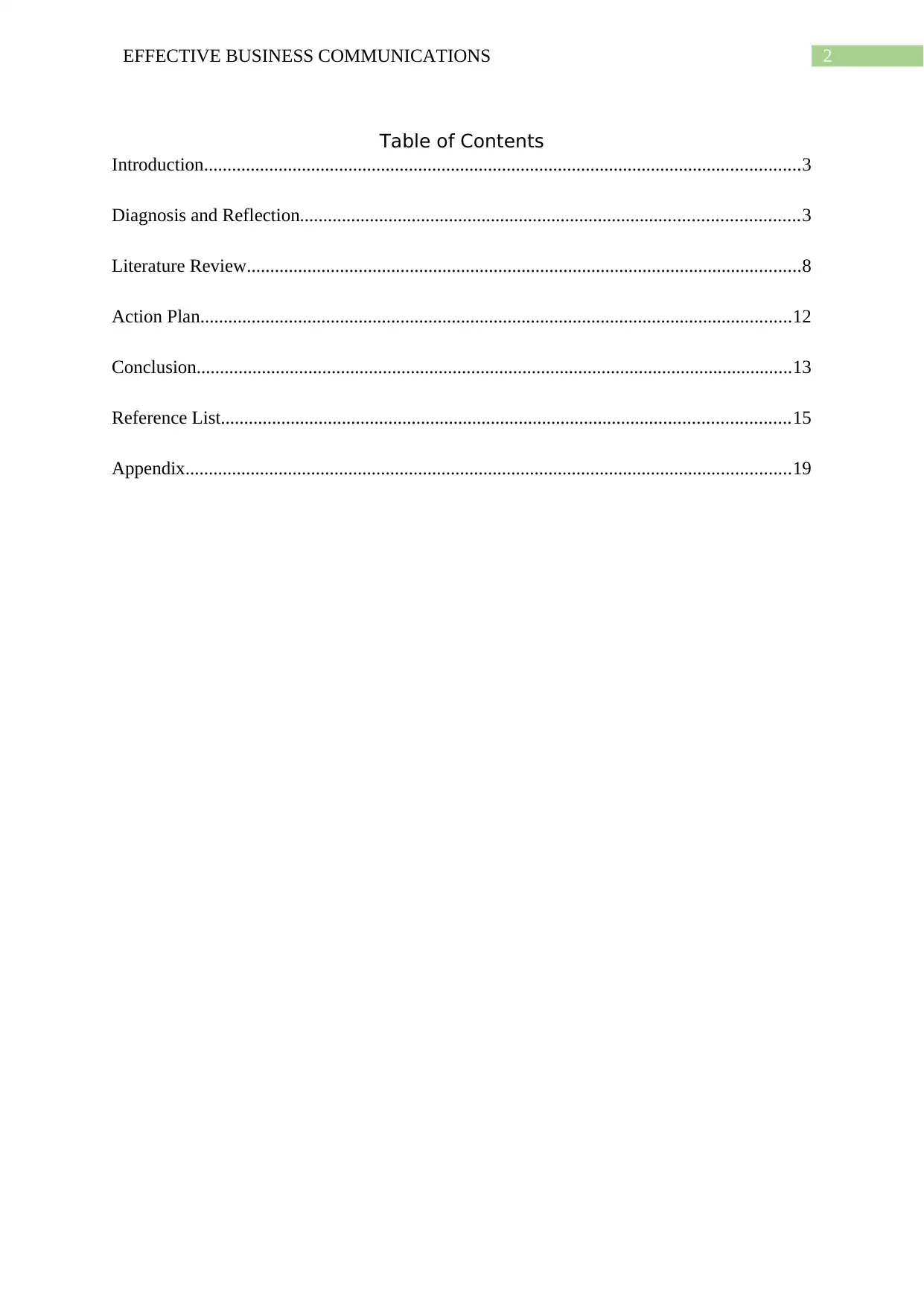
2EFFECTIVE BUSINESS COMMUNICATIONS
Table of Contents
Introduction................................................................................................................................3
Diagnosis and Reflection...........................................................................................................3
Literature Review.......................................................................................................................8
Action Plan...............................................................................................................................12
Conclusion................................................................................................................................13
Reference List..........................................................................................................................15
Appendix..................................................................................................................................19
Table of Contents
Introduction................................................................................................................................3
Diagnosis and Reflection...........................................................................................................3
Literature Review.......................................................................................................................8
Action Plan...............................................................................................................................12
Conclusion................................................................................................................................13
Reference List..........................................................................................................................15
Appendix..................................................................................................................................19
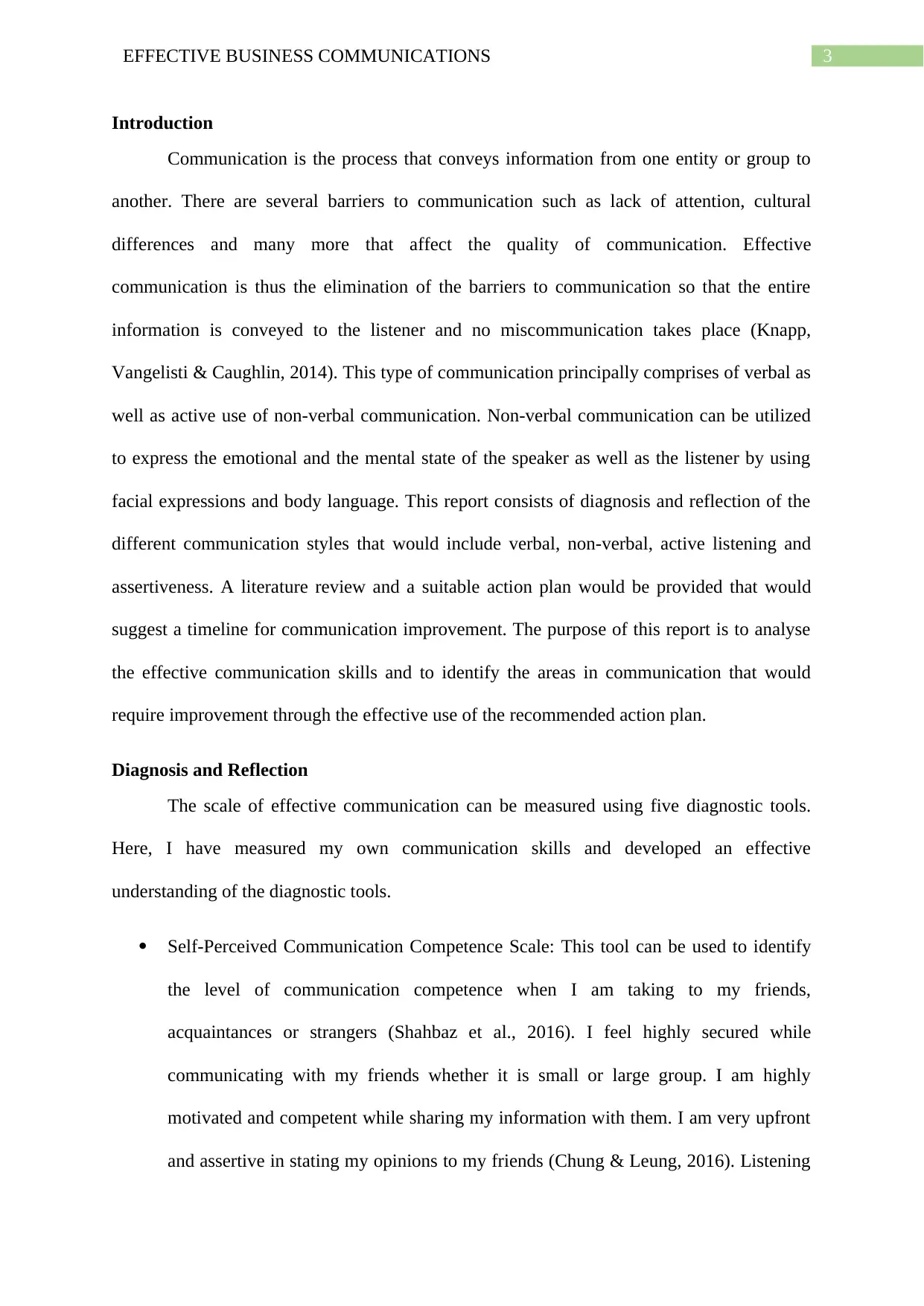
3EFFECTIVE BUSINESS COMMUNICATIONS
Introduction
Communication is the process that conveys information from one entity or group to
another. There are several barriers to communication such as lack of attention, cultural
differences and many more that affect the quality of communication. Effective
communication is thus the elimination of the barriers to communication so that the entire
information is conveyed to the listener and no miscommunication takes place (Knapp,
Vangelisti & Caughlin, 2014). This type of communication principally comprises of verbal as
well as active use of non-verbal communication. Non-verbal communication can be utilized
to express the emotional and the mental state of the speaker as well as the listener by using
facial expressions and body language. This report consists of diagnosis and reflection of the
different communication styles that would include verbal, non-verbal, active listening and
assertiveness. A literature review and a suitable action plan would be provided that would
suggest a timeline for communication improvement. The purpose of this report is to analyse
the effective communication skills and to identify the areas in communication that would
require improvement through the effective use of the recommended action plan.
Diagnosis and Reflection
The scale of effective communication can be measured using five diagnostic tools.
Here, I have measured my own communication skills and developed an effective
understanding of the diagnostic tools.
Self-Perceived Communication Competence Scale: This tool can be used to identify
the level of communication competence when I am taking to my friends,
acquaintances or strangers (Shahbaz et al., 2016). I feel highly secured while
communicating with my friends whether it is small or large group. I am highly
motivated and competent while sharing my information with them. I am very upfront
and assertive in stating my opinions to my friends (Chung & Leung, 2016). Listening
Introduction
Communication is the process that conveys information from one entity or group to
another. There are several barriers to communication such as lack of attention, cultural
differences and many more that affect the quality of communication. Effective
communication is thus the elimination of the barriers to communication so that the entire
information is conveyed to the listener and no miscommunication takes place (Knapp,
Vangelisti & Caughlin, 2014). This type of communication principally comprises of verbal as
well as active use of non-verbal communication. Non-verbal communication can be utilized
to express the emotional and the mental state of the speaker as well as the listener by using
facial expressions and body language. This report consists of diagnosis and reflection of the
different communication styles that would include verbal, non-verbal, active listening and
assertiveness. A literature review and a suitable action plan would be provided that would
suggest a timeline for communication improvement. The purpose of this report is to analyse
the effective communication skills and to identify the areas in communication that would
require improvement through the effective use of the recommended action plan.
Diagnosis and Reflection
The scale of effective communication can be measured using five diagnostic tools.
Here, I have measured my own communication skills and developed an effective
understanding of the diagnostic tools.
Self-Perceived Communication Competence Scale: This tool can be used to identify
the level of communication competence when I am taking to my friends,
acquaintances or strangers (Shahbaz et al., 2016). I feel highly secured while
communicating with my friends whether it is small or large group. I am highly
motivated and competent while sharing my information with them. I am very upfront
and assertive in stating my opinions to my friends (Chung & Leung, 2016). Listening
Secure Best Marks with AI Grader
Need help grading? Try our AI Grader for instant feedback on your assignments.

4EFFECTIVE BUSINESS COMMUNICATIONS
to their opinions is also very satisfying as I have known them for a long time and I
know that their source of knowledge is authentic. I am averagely competent while
talking to any acquaintance from my workplace. Being a little defensive while
communicating with them is always beneficial as I have little to no idea about their
thought process. Communicating with only one person or a small group of workplace
acquaintances is generally good for information sharing (Li, 2014). I prefer
individuals or small groups to talk at my workplace to as the conversation often leads
to rich quality information sharing. Large group meetings of acquaintances are not
preferred by me as most of the discussion is only for merriment and not work related.
I very assertive while taking to individuals or when I am communicating in a small
group. However, I am not assertive during my conversations with a large group of
acquaintances. Having a conversation with a stranger has never been my speciality. I
do not share much details about myself while having a conversation with them. My
body language is extremely defensive, I am a moderately active listener and I do not
show any assertiveness.
Personal Report of Intercultural Communication Apprehension: This diagnostic tool
helped me to identify my communication skill while communicating people from
different cultural backgrounds (Neuliep, 2017). Identifying the flaws and backlogs in
this domain of communication is vital as I will have to work with different people in
my team, many of them might be from other countries. Such a situation would mean
that I would have to be comfortable working with them by effectively communicating
with them. I have analysed, by using this tool that I am very comfortable while
communicating with people from different cultural backgrounds. I tend to read
foreign books related to cultural practices followed around the world (Jandt, 2017).
Thus, I am not all nervous while communicating with them. I face no such fear while
to their opinions is also very satisfying as I have known them for a long time and I
know that their source of knowledge is authentic. I am averagely competent while
talking to any acquaintance from my workplace. Being a little defensive while
communicating with them is always beneficial as I have little to no idea about their
thought process. Communicating with only one person or a small group of workplace
acquaintances is generally good for information sharing (Li, 2014). I prefer
individuals or small groups to talk at my workplace to as the conversation often leads
to rich quality information sharing. Large group meetings of acquaintances are not
preferred by me as most of the discussion is only for merriment and not work related.
I very assertive while taking to individuals or when I am communicating in a small
group. However, I am not assertive during my conversations with a large group of
acquaintances. Having a conversation with a stranger has never been my speciality. I
do not share much details about myself while having a conversation with them. My
body language is extremely defensive, I am a moderately active listener and I do not
show any assertiveness.
Personal Report of Intercultural Communication Apprehension: This diagnostic tool
helped me to identify my communication skill while communicating people from
different cultural backgrounds (Neuliep, 2017). Identifying the flaws and backlogs in
this domain of communication is vital as I will have to work with different people in
my team, many of them might be from other countries. Such a situation would mean
that I would have to be comfortable working with them by effectively communicating
with them. I have analysed, by using this tool that I am very comfortable while
communicating with people from different cultural backgrounds. I tend to read
foreign books related to cultural practices followed around the world (Jandt, 2017).
Thus, I am not all nervous while communicating with them. I face no such fear while
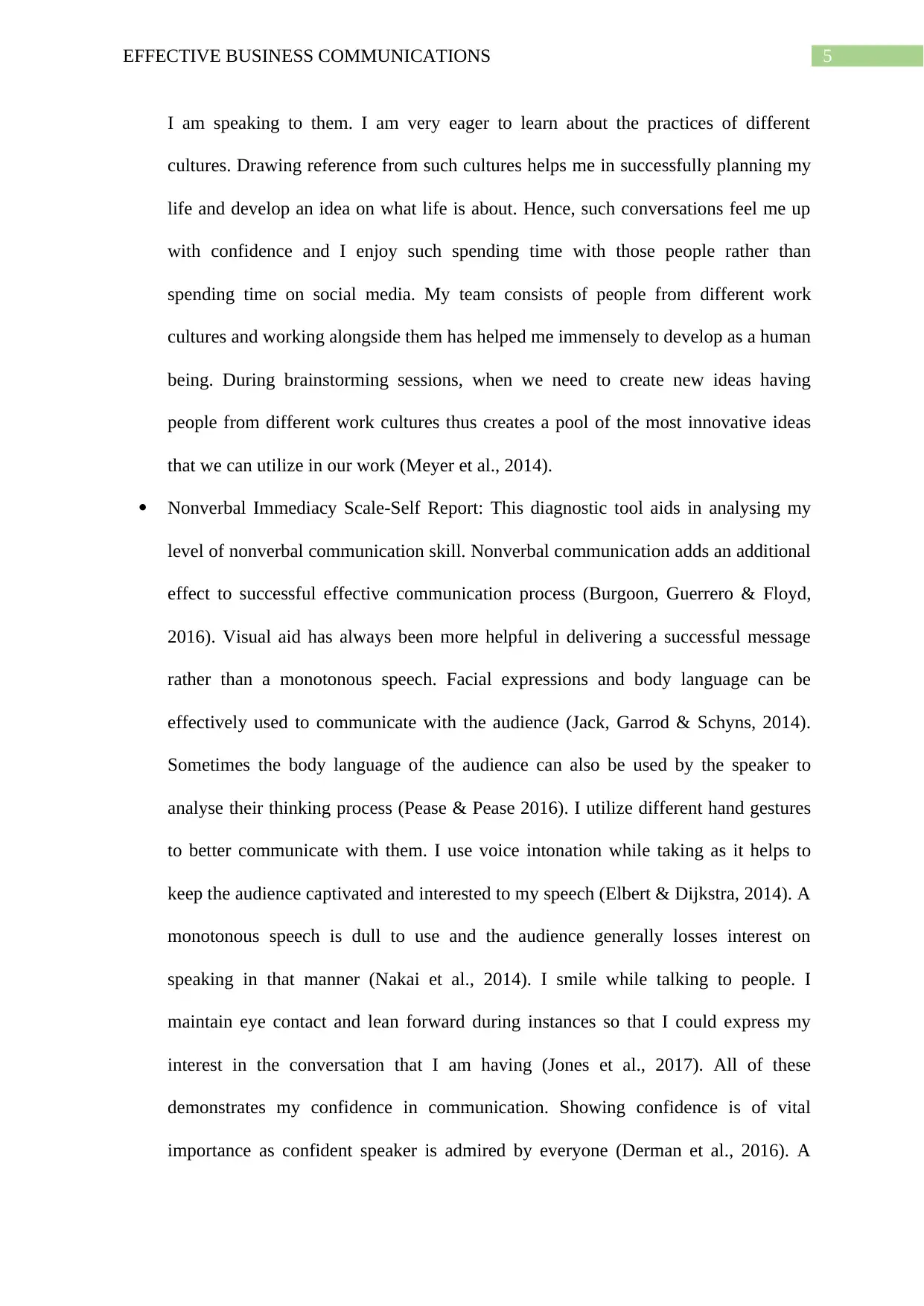
5EFFECTIVE BUSINESS COMMUNICATIONS
I am speaking to them. I am very eager to learn about the practices of different
cultures. Drawing reference from such cultures helps me in successfully planning my
life and develop an idea on what life is about. Hence, such conversations feel me up
with confidence and I enjoy such spending time with those people rather than
spending time on social media. My team consists of people from different work
cultures and working alongside them has helped me immensely to develop as a human
being. During brainstorming sessions, when we need to create new ideas having
people from different work cultures thus creates a pool of the most innovative ideas
that we can utilize in our work (Meyer et al., 2014).
Nonverbal Immediacy Scale-Self Report: This diagnostic tool aids in analysing my
level of nonverbal communication skill. Nonverbal communication adds an additional
effect to successful effective communication process (Burgoon, Guerrero & Floyd,
2016). Visual aid has always been more helpful in delivering a successful message
rather than a monotonous speech. Facial expressions and body language can be
effectively used to communicate with the audience (Jack, Garrod & Schyns, 2014).
Sometimes the body language of the audience can also be used by the speaker to
analyse their thinking process (Pease & Pease 2016). I utilize different hand gestures
to better communicate with them. I use voice intonation while taking as it helps to
keep the audience captivated and interested to my speech (Elbert & Dijkstra, 2014). A
monotonous speech is dull to use and the audience generally losses interest on
speaking in that manner (Nakai et al., 2014). I smile while talking to people. I
maintain eye contact and lean forward during instances so that I could express my
interest in the conversation that I am having (Jones et al., 2017). All of these
demonstrates my confidence in communication. Showing confidence is of vital
importance as confident speaker is admired by everyone (Derman et al., 2016). A
I am speaking to them. I am very eager to learn about the practices of different
cultures. Drawing reference from such cultures helps me in successfully planning my
life and develop an idea on what life is about. Hence, such conversations feel me up
with confidence and I enjoy such spending time with those people rather than
spending time on social media. My team consists of people from different work
cultures and working alongside them has helped me immensely to develop as a human
being. During brainstorming sessions, when we need to create new ideas having
people from different work cultures thus creates a pool of the most innovative ideas
that we can utilize in our work (Meyer et al., 2014).
Nonverbal Immediacy Scale-Self Report: This diagnostic tool aids in analysing my
level of nonverbal communication skill. Nonverbal communication adds an additional
effect to successful effective communication process (Burgoon, Guerrero & Floyd,
2016). Visual aid has always been more helpful in delivering a successful message
rather than a monotonous speech. Facial expressions and body language can be
effectively used to communicate with the audience (Jack, Garrod & Schyns, 2014).
Sometimes the body language of the audience can also be used by the speaker to
analyse their thinking process (Pease & Pease 2016). I utilize different hand gestures
to better communicate with them. I use voice intonation while taking as it helps to
keep the audience captivated and interested to my speech (Elbert & Dijkstra, 2014). A
monotonous speech is dull to use and the audience generally losses interest on
speaking in that manner (Nakai et al., 2014). I smile while talking to people. I
maintain eye contact and lean forward during instances so that I could express my
interest in the conversation that I am having (Jones et al., 2017). All of these
demonstrates my confidence in communication. Showing confidence is of vital
importance as confident speaker is admired by everyone (Derman et al., 2016). A
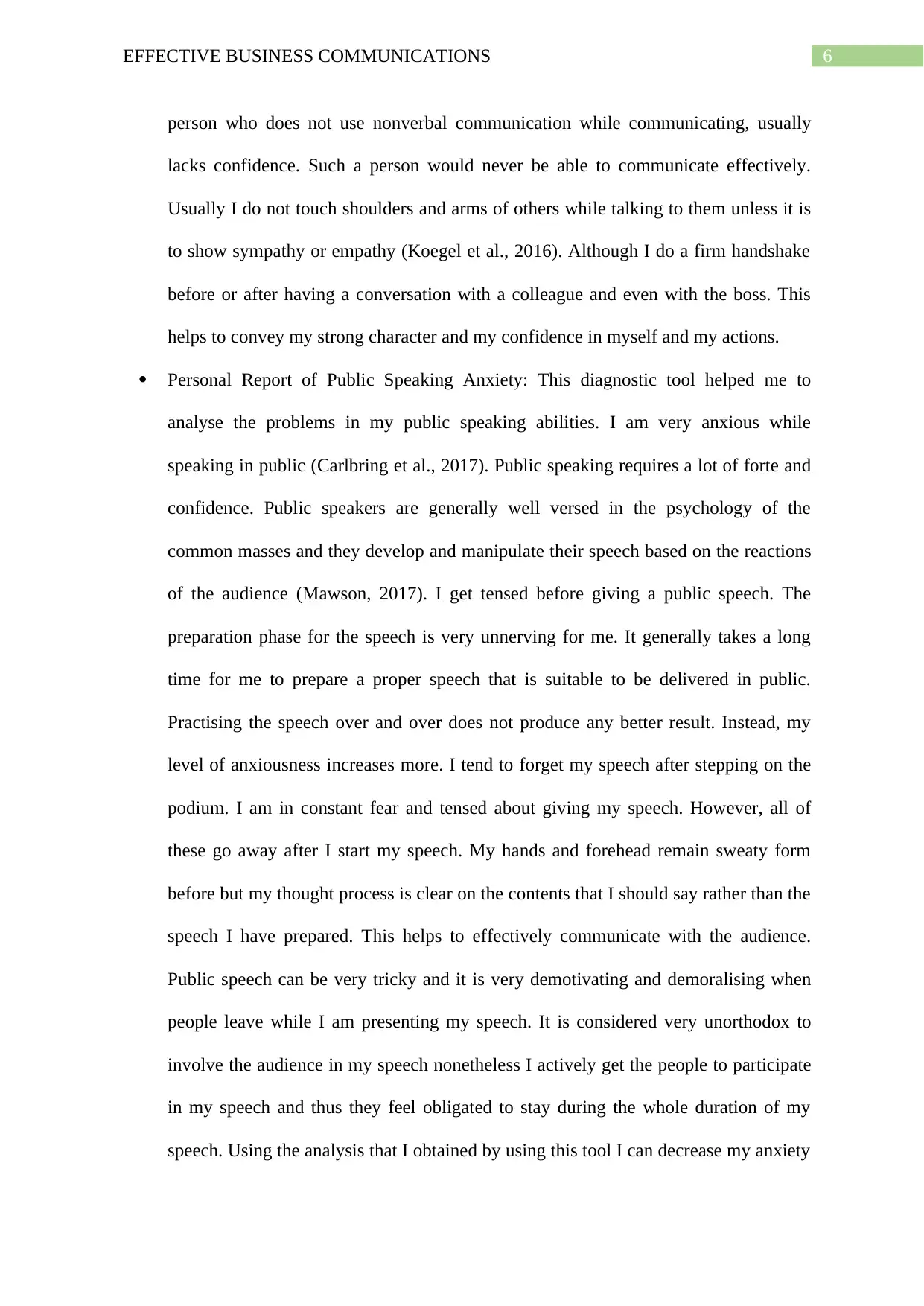
6EFFECTIVE BUSINESS COMMUNICATIONS
person who does not use nonverbal communication while communicating, usually
lacks confidence. Such a person would never be able to communicate effectively.
Usually I do not touch shoulders and arms of others while talking to them unless it is
to show sympathy or empathy (Koegel et al., 2016). Although I do a firm handshake
before or after having a conversation with a colleague and even with the boss. This
helps to convey my strong character and my confidence in myself and my actions.
Personal Report of Public Speaking Anxiety: This diagnostic tool helped me to
analyse the problems in my public speaking abilities. I am very anxious while
speaking in public (Carlbring et al., 2017). Public speaking requires a lot of forte and
confidence. Public speakers are generally well versed in the psychology of the
common masses and they develop and manipulate their speech based on the reactions
of the audience (Mawson, 2017). I get tensed before giving a public speech. The
preparation phase for the speech is very unnerving for me. It generally takes a long
time for me to prepare a proper speech that is suitable to be delivered in public.
Practising the speech over and over does not produce any better result. Instead, my
level of anxiousness increases more. I tend to forget my speech after stepping on the
podium. I am in constant fear and tensed about giving my speech. However, all of
these go away after I start my speech. My hands and forehead remain sweaty form
before but my thought process is clear on the contents that I should say rather than the
speech I have prepared. This helps to effectively communicate with the audience.
Public speech can be very tricky and it is very demotivating and demoralising when
people leave while I am presenting my speech. It is considered very unorthodox to
involve the audience in my speech nonetheless I actively get the people to participate
in my speech and thus they feel obligated to stay during the whole duration of my
speech. Using the analysis that I obtained by using this tool I can decrease my anxiety
person who does not use nonverbal communication while communicating, usually
lacks confidence. Such a person would never be able to communicate effectively.
Usually I do not touch shoulders and arms of others while talking to them unless it is
to show sympathy or empathy (Koegel et al., 2016). Although I do a firm handshake
before or after having a conversation with a colleague and even with the boss. This
helps to convey my strong character and my confidence in myself and my actions.
Personal Report of Public Speaking Anxiety: This diagnostic tool helped me to
analyse the problems in my public speaking abilities. I am very anxious while
speaking in public (Carlbring et al., 2017). Public speaking requires a lot of forte and
confidence. Public speakers are generally well versed in the psychology of the
common masses and they develop and manipulate their speech based on the reactions
of the audience (Mawson, 2017). I get tensed before giving a public speech. The
preparation phase for the speech is very unnerving for me. It generally takes a long
time for me to prepare a proper speech that is suitable to be delivered in public.
Practising the speech over and over does not produce any better result. Instead, my
level of anxiousness increases more. I tend to forget my speech after stepping on the
podium. I am in constant fear and tensed about giving my speech. However, all of
these go away after I start my speech. My hands and forehead remain sweaty form
before but my thought process is clear on the contents that I should say rather than the
speech I have prepared. This helps to effectively communicate with the audience.
Public speech can be very tricky and it is very demotivating and demoralising when
people leave while I am presenting my speech. It is considered very unorthodox to
involve the audience in my speech nonetheless I actively get the people to participate
in my speech and thus they feel obligated to stay during the whole duration of my
speech. Using the analysis that I obtained by using this tool I can decrease my anxiety
Paraphrase This Document
Need a fresh take? Get an instant paraphrase of this document with our AI Paraphraser
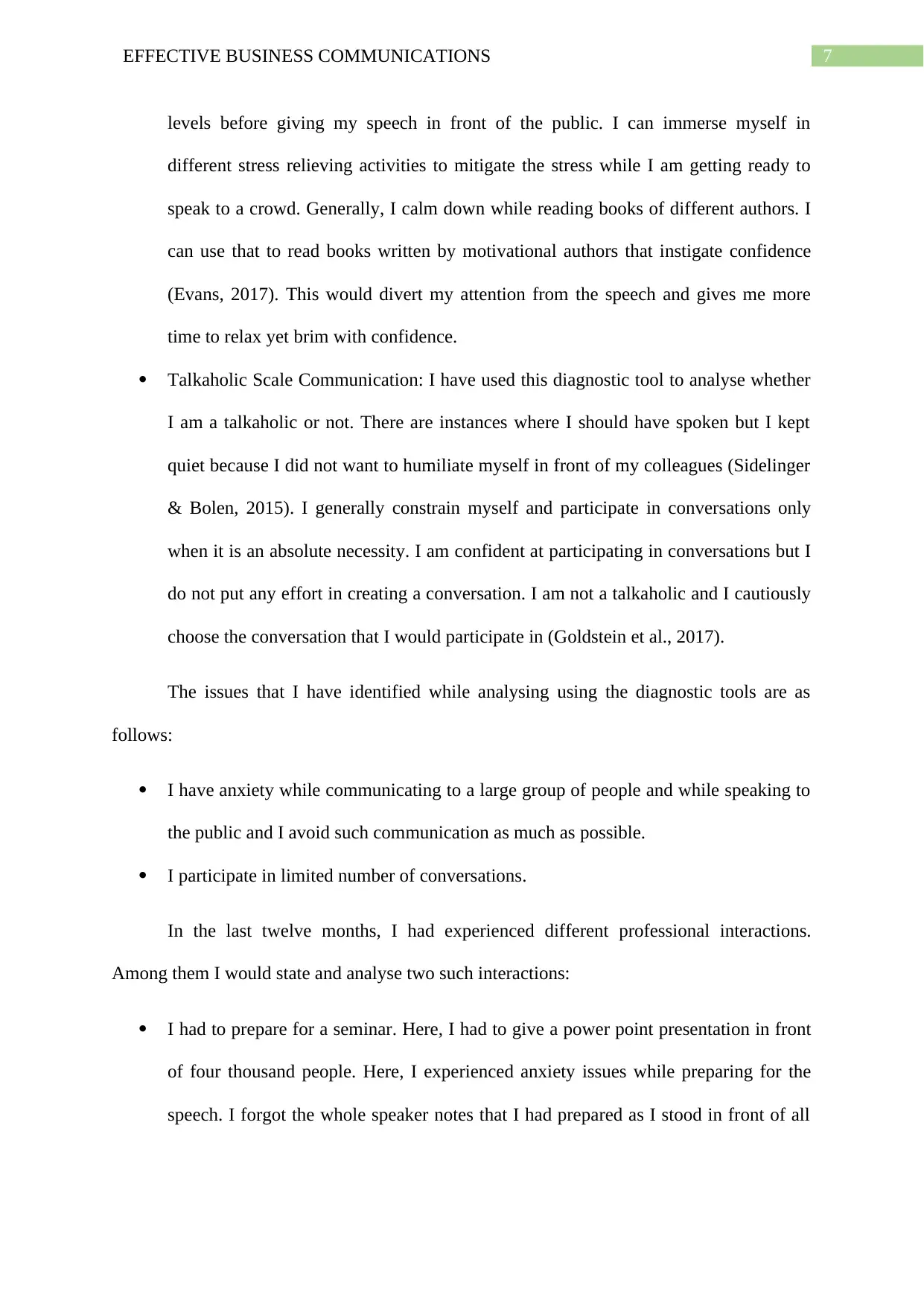
7EFFECTIVE BUSINESS COMMUNICATIONS
levels before giving my speech in front of the public. I can immerse myself in
different stress relieving activities to mitigate the stress while I am getting ready to
speak to a crowd. Generally, I calm down while reading books of different authors. I
can use that to read books written by motivational authors that instigate confidence
(Evans, 2017). This would divert my attention from the speech and gives me more
time to relax yet brim with confidence.
Talkaholic Scale Communication: I have used this diagnostic tool to analyse whether
I am a talkaholic or not. There are instances where I should have spoken but I kept
quiet because I did not want to humiliate myself in front of my colleagues (Sidelinger
& Bolen, 2015). I generally constrain myself and participate in conversations only
when it is an absolute necessity. I am confident at participating in conversations but I
do not put any effort in creating a conversation. I am not a talkaholic and I cautiously
choose the conversation that I would participate in (Goldstein et al., 2017).
The issues that I have identified while analysing using the diagnostic tools are as
follows:
I have anxiety while communicating to a large group of people and while speaking to
the public and I avoid such communication as much as possible.
I participate in limited number of conversations.
In the last twelve months, I had experienced different professional interactions.
Among them I would state and analyse two such interactions:
I had to prepare for a seminar. Here, I had to give a power point presentation in front
of four thousand people. Here, I experienced anxiety issues while preparing for the
speech. I forgot the whole speaker notes that I had prepared as I stood in front of all
levels before giving my speech in front of the public. I can immerse myself in
different stress relieving activities to mitigate the stress while I am getting ready to
speak to a crowd. Generally, I calm down while reading books of different authors. I
can use that to read books written by motivational authors that instigate confidence
(Evans, 2017). This would divert my attention from the speech and gives me more
time to relax yet brim with confidence.
Talkaholic Scale Communication: I have used this diagnostic tool to analyse whether
I am a talkaholic or not. There are instances where I should have spoken but I kept
quiet because I did not want to humiliate myself in front of my colleagues (Sidelinger
& Bolen, 2015). I generally constrain myself and participate in conversations only
when it is an absolute necessity. I am confident at participating in conversations but I
do not put any effort in creating a conversation. I am not a talkaholic and I cautiously
choose the conversation that I would participate in (Goldstein et al., 2017).
The issues that I have identified while analysing using the diagnostic tools are as
follows:
I have anxiety while communicating to a large group of people and while speaking to
the public and I avoid such communication as much as possible.
I participate in limited number of conversations.
In the last twelve months, I had experienced different professional interactions.
Among them I would state and analyse two such interactions:
I had to prepare for a seminar. Here, I had to give a power point presentation in front
of four thousand people. Here, I experienced anxiety issues while preparing for the
speech. I forgot the whole speaker notes that I had prepared as I stood in front of all
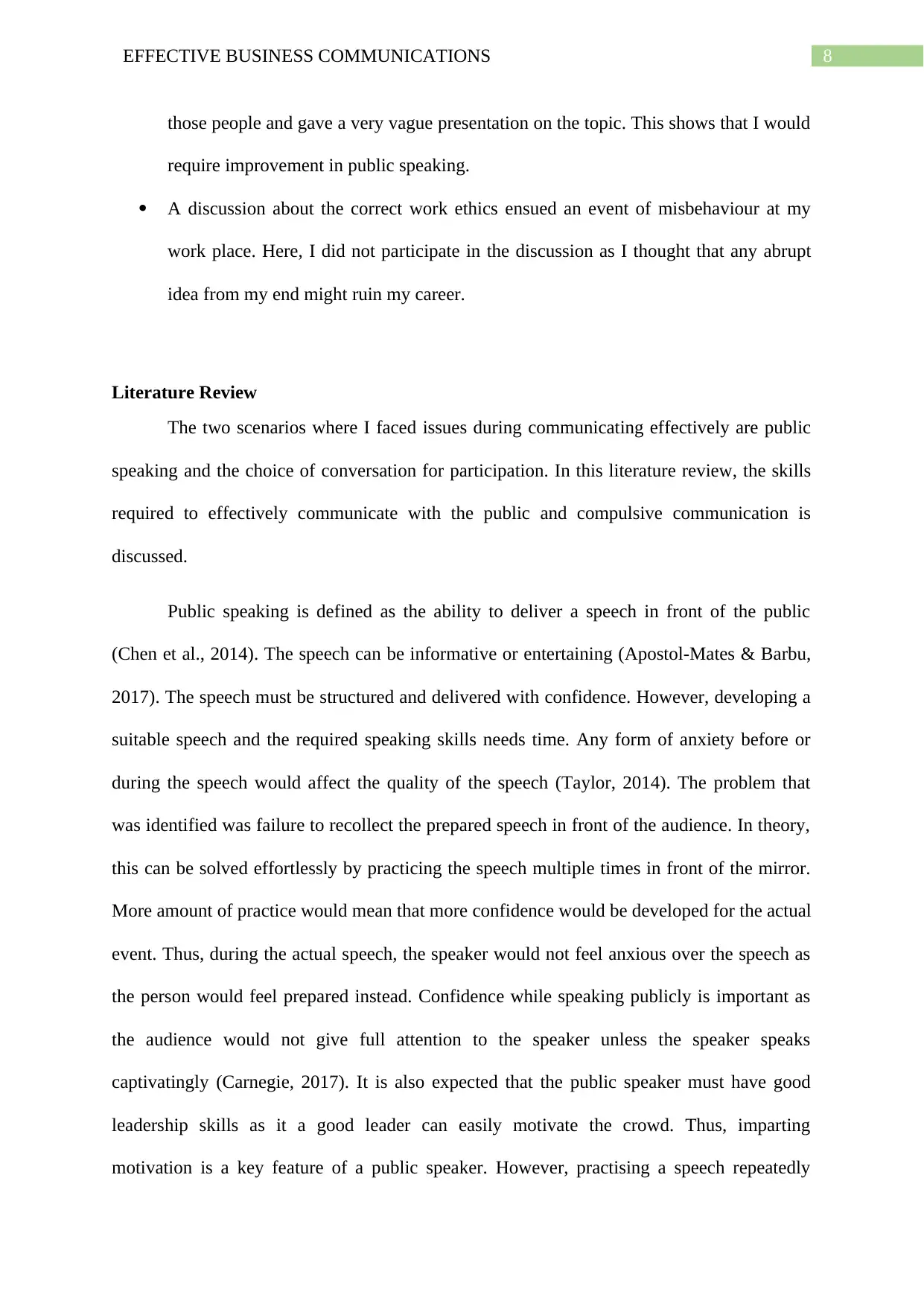
8EFFECTIVE BUSINESS COMMUNICATIONS
those people and gave a very vague presentation on the topic. This shows that I would
require improvement in public speaking.
A discussion about the correct work ethics ensued an event of misbehaviour at my
work place. Here, I did not participate in the discussion as I thought that any abrupt
idea from my end might ruin my career.
Literature Review
The two scenarios where I faced issues during communicating effectively are public
speaking and the choice of conversation for participation. In this literature review, the skills
required to effectively communicate with the public and compulsive communication is
discussed.
Public speaking is defined as the ability to deliver a speech in front of the public
(Chen et al., 2014). The speech can be informative or entertaining (Apostol-Mates & Barbu,
2017). The speech must be structured and delivered with confidence. However, developing a
suitable speech and the required speaking skills needs time. Any form of anxiety before or
during the speech would affect the quality of the speech (Taylor, 2014). The problem that
was identified was failure to recollect the prepared speech in front of the audience. In theory,
this can be solved effortlessly by practicing the speech multiple times in front of the mirror.
More amount of practice would mean that more confidence would be developed for the actual
event. Thus, during the actual speech, the speaker would not feel anxious over the speech as
the person would feel prepared instead. Confidence while speaking publicly is important as
the audience would not give full attention to the speaker unless the speaker speaks
captivatingly (Carnegie, 2017). It is also expected that the public speaker must have good
leadership skills as it a good leader can easily motivate the crowd. Thus, imparting
motivation is a key feature of a public speaker. However, practising a speech repeatedly
those people and gave a very vague presentation on the topic. This shows that I would
require improvement in public speaking.
A discussion about the correct work ethics ensued an event of misbehaviour at my
work place. Here, I did not participate in the discussion as I thought that any abrupt
idea from my end might ruin my career.
Literature Review
The two scenarios where I faced issues during communicating effectively are public
speaking and the choice of conversation for participation. In this literature review, the skills
required to effectively communicate with the public and compulsive communication is
discussed.
Public speaking is defined as the ability to deliver a speech in front of the public
(Chen et al., 2014). The speech can be informative or entertaining (Apostol-Mates & Barbu,
2017). The speech must be structured and delivered with confidence. However, developing a
suitable speech and the required speaking skills needs time. Any form of anxiety before or
during the speech would affect the quality of the speech (Taylor, 2014). The problem that
was identified was failure to recollect the prepared speech in front of the audience. In theory,
this can be solved effortlessly by practicing the speech multiple times in front of the mirror.
More amount of practice would mean that more confidence would be developed for the actual
event. Thus, during the actual speech, the speaker would not feel anxious over the speech as
the person would feel prepared instead. Confidence while speaking publicly is important as
the audience would not give full attention to the speaker unless the speaker speaks
captivatingly (Carnegie, 2017). It is also expected that the public speaker must have good
leadership skills as it a good leader can easily motivate the crowd. Thus, imparting
motivation is a key feature of a public speaker. However, practising a speech repeatedly
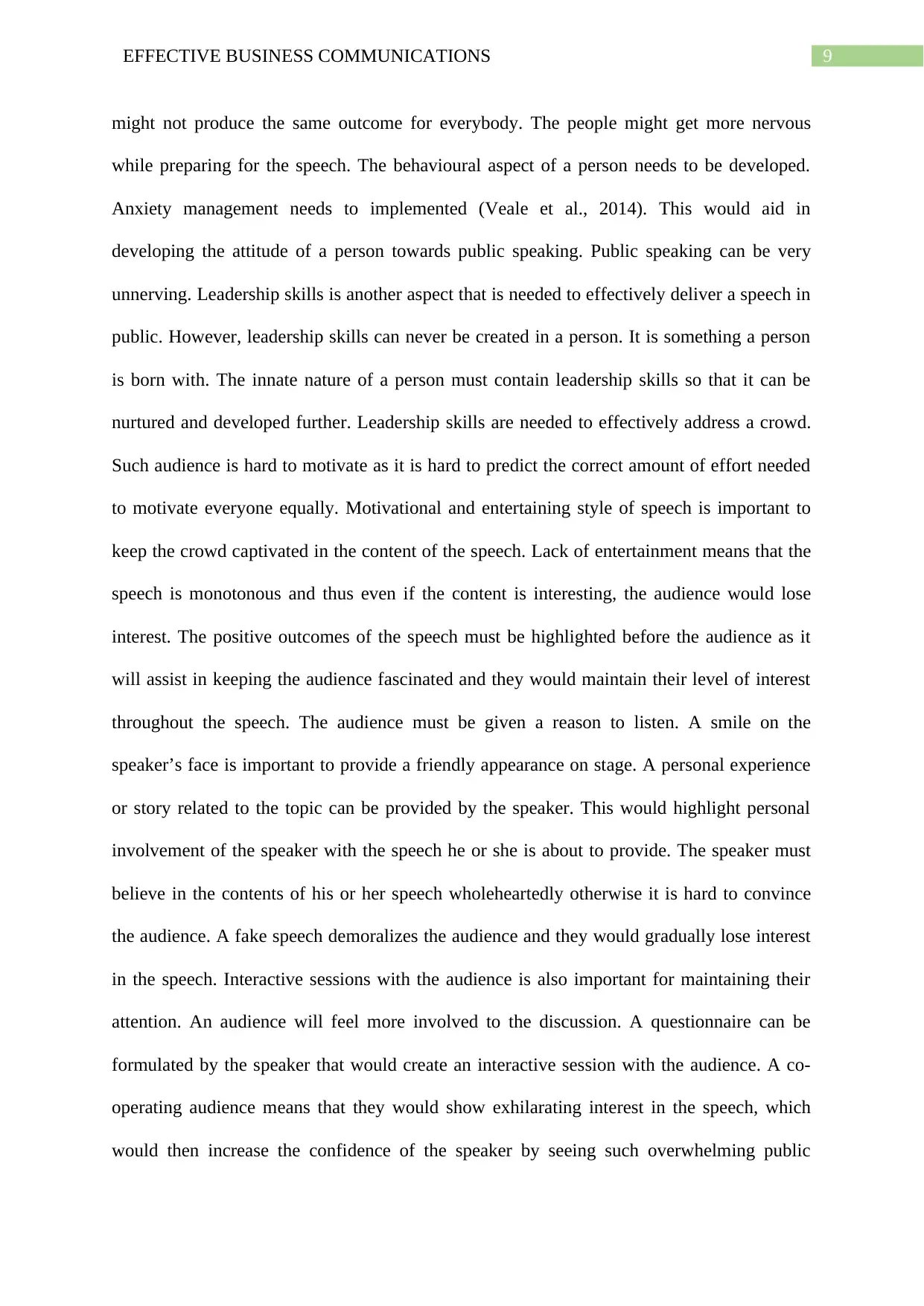
9EFFECTIVE BUSINESS COMMUNICATIONS
might not produce the same outcome for everybody. The people might get more nervous
while preparing for the speech. The behavioural aspect of a person needs to be developed.
Anxiety management needs to implemented (Veale et al., 2014). This would aid in
developing the attitude of a person towards public speaking. Public speaking can be very
unnerving. Leadership skills is another aspect that is needed to effectively deliver a speech in
public. However, leadership skills can never be created in a person. It is something a person
is born with. The innate nature of a person must contain leadership skills so that it can be
nurtured and developed further. Leadership skills are needed to effectively address a crowd.
Such audience is hard to motivate as it is hard to predict the correct amount of effort needed
to motivate everyone equally. Motivational and entertaining style of speech is important to
keep the crowd captivated in the content of the speech. Lack of entertainment means that the
speech is monotonous and thus even if the content is interesting, the audience would lose
interest. The positive outcomes of the speech must be highlighted before the audience as it
will assist in keeping the audience fascinated and they would maintain their level of interest
throughout the speech. The audience must be given a reason to listen. A smile on the
speaker’s face is important to provide a friendly appearance on stage. A personal experience
or story related to the topic can be provided by the speaker. This would highlight personal
involvement of the speaker with the speech he or she is about to provide. The speaker must
believe in the contents of his or her speech wholeheartedly otherwise it is hard to convince
the audience. A fake speech demoralizes the audience and they would gradually lose interest
in the speech. Interactive sessions with the audience is also important for maintaining their
attention. An audience will feel more involved to the discussion. A questionnaire can be
formulated by the speaker that would create an interactive session with the audience. A co-
operating audience means that they would show exhilarating interest in the speech, which
would then increase the confidence of the speaker by seeing such overwhelming public
might not produce the same outcome for everybody. The people might get more nervous
while preparing for the speech. The behavioural aspect of a person needs to be developed.
Anxiety management needs to implemented (Veale et al., 2014). This would aid in
developing the attitude of a person towards public speaking. Public speaking can be very
unnerving. Leadership skills is another aspect that is needed to effectively deliver a speech in
public. However, leadership skills can never be created in a person. It is something a person
is born with. The innate nature of a person must contain leadership skills so that it can be
nurtured and developed further. Leadership skills are needed to effectively address a crowd.
Such audience is hard to motivate as it is hard to predict the correct amount of effort needed
to motivate everyone equally. Motivational and entertaining style of speech is important to
keep the crowd captivated in the content of the speech. Lack of entertainment means that the
speech is monotonous and thus even if the content is interesting, the audience would lose
interest. The positive outcomes of the speech must be highlighted before the audience as it
will assist in keeping the audience fascinated and they would maintain their level of interest
throughout the speech. The audience must be given a reason to listen. A smile on the
speaker’s face is important to provide a friendly appearance on stage. A personal experience
or story related to the topic can be provided by the speaker. This would highlight personal
involvement of the speaker with the speech he or she is about to provide. The speaker must
believe in the contents of his or her speech wholeheartedly otherwise it is hard to convince
the audience. A fake speech demoralizes the audience and they would gradually lose interest
in the speech. Interactive sessions with the audience is also important for maintaining their
attention. An audience will feel more involved to the discussion. A questionnaire can be
formulated by the speaker that would create an interactive session with the audience. A co-
operating audience means that they would show exhilarating interest in the speech, which
would then increase the confidence of the speaker by seeing such overwhelming public
Secure Best Marks with AI Grader
Need help grading? Try our AI Grader for instant feedback on your assignments.
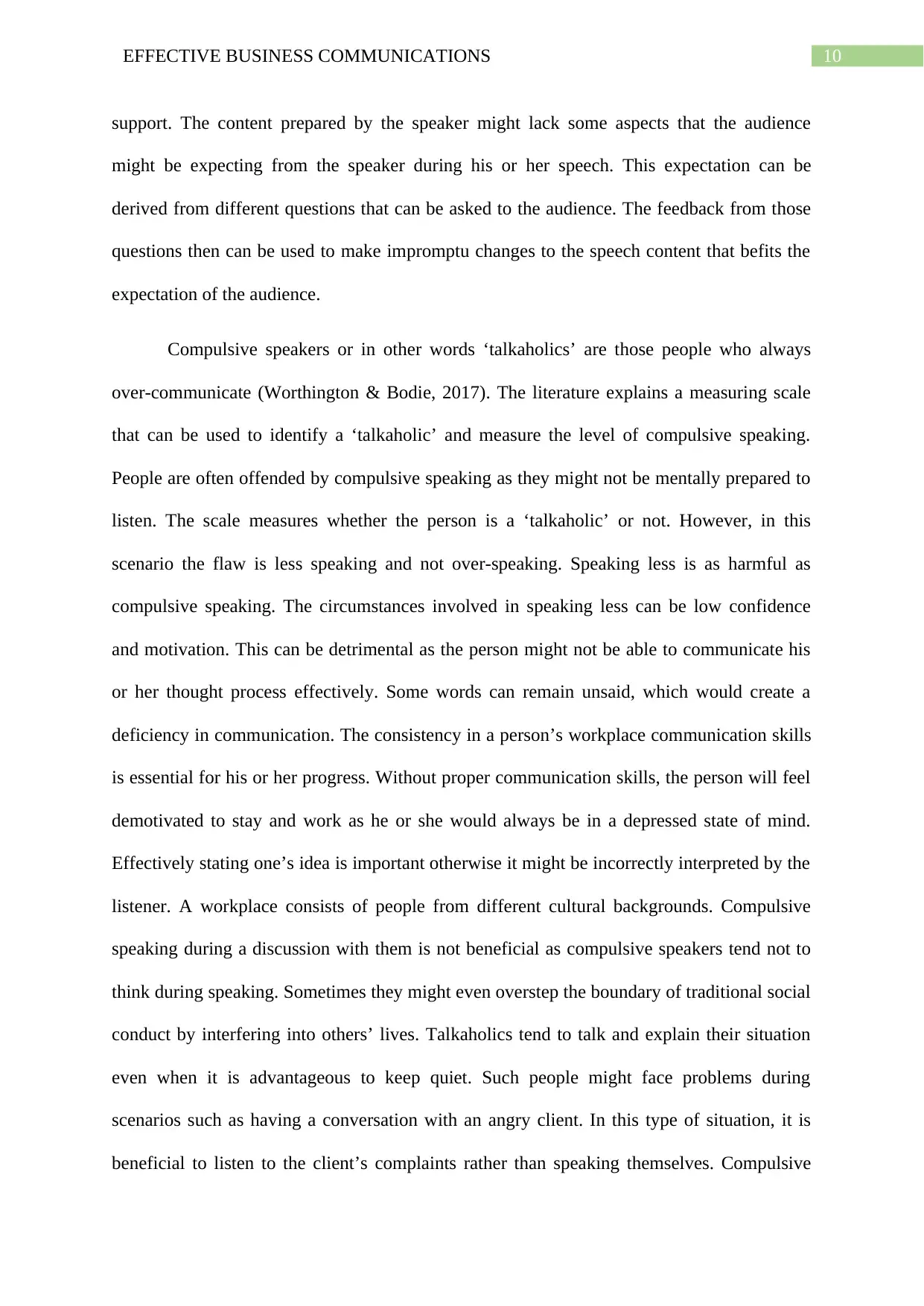
10EFFECTIVE BUSINESS COMMUNICATIONS
support. The content prepared by the speaker might lack some aspects that the audience
might be expecting from the speaker during his or her speech. This expectation can be
derived from different questions that can be asked to the audience. The feedback from those
questions then can be used to make impromptu changes to the speech content that befits the
expectation of the audience.
Compulsive speakers or in other words ‘talkaholics’ are those people who always
over-communicate (Worthington & Bodie, 2017). The literature explains a measuring scale
that can be used to identify a ‘talkaholic’ and measure the level of compulsive speaking.
People are often offended by compulsive speaking as they might not be mentally prepared to
listen. The scale measures whether the person is a ‘talkaholic’ or not. However, in this
scenario the flaw is less speaking and not over-speaking. Speaking less is as harmful as
compulsive speaking. The circumstances involved in speaking less can be low confidence
and motivation. This can be detrimental as the person might not be able to communicate his
or her thought process effectively. Some words can remain unsaid, which would create a
deficiency in communication. The consistency in a person’s workplace communication skills
is essential for his or her progress. Without proper communication skills, the person will feel
demotivated to stay and work as he or she would always be in a depressed state of mind.
Effectively stating one’s idea is important otherwise it might be incorrectly interpreted by the
listener. A workplace consists of people from different cultural backgrounds. Compulsive
speaking during a discussion with them is not beneficial as compulsive speakers tend not to
think during speaking. Sometimes they might even overstep the boundary of traditional social
conduct by interfering into others’ lives. Talkaholics tend to talk and explain their situation
even when it is advantageous to keep quiet. Such people might face problems during
scenarios such as having a conversation with an angry client. In this type of situation, it is
beneficial to listen to the client’s complaints rather than speaking themselves. Compulsive
support. The content prepared by the speaker might lack some aspects that the audience
might be expecting from the speaker during his or her speech. This expectation can be
derived from different questions that can be asked to the audience. The feedback from those
questions then can be used to make impromptu changes to the speech content that befits the
expectation of the audience.
Compulsive speakers or in other words ‘talkaholics’ are those people who always
over-communicate (Worthington & Bodie, 2017). The literature explains a measuring scale
that can be used to identify a ‘talkaholic’ and measure the level of compulsive speaking.
People are often offended by compulsive speaking as they might not be mentally prepared to
listen. The scale measures whether the person is a ‘talkaholic’ or not. However, in this
scenario the flaw is less speaking and not over-speaking. Speaking less is as harmful as
compulsive speaking. The circumstances involved in speaking less can be low confidence
and motivation. This can be detrimental as the person might not be able to communicate his
or her thought process effectively. Some words can remain unsaid, which would create a
deficiency in communication. The consistency in a person’s workplace communication skills
is essential for his or her progress. Without proper communication skills, the person will feel
demotivated to stay and work as he or she would always be in a depressed state of mind.
Effectively stating one’s idea is important otherwise it might be incorrectly interpreted by the
listener. A workplace consists of people from different cultural backgrounds. Compulsive
speaking during a discussion with them is not beneficial as compulsive speakers tend not to
think during speaking. Sometimes they might even overstep the boundary of traditional social
conduct by interfering into others’ lives. Talkaholics tend to talk and explain their situation
even when it is advantageous to keep quiet. Such people might face problems during
scenarios such as having a conversation with an angry client. In this type of situation, it is
beneficial to listen to the client’s complaints rather than speaking themselves. Compulsive
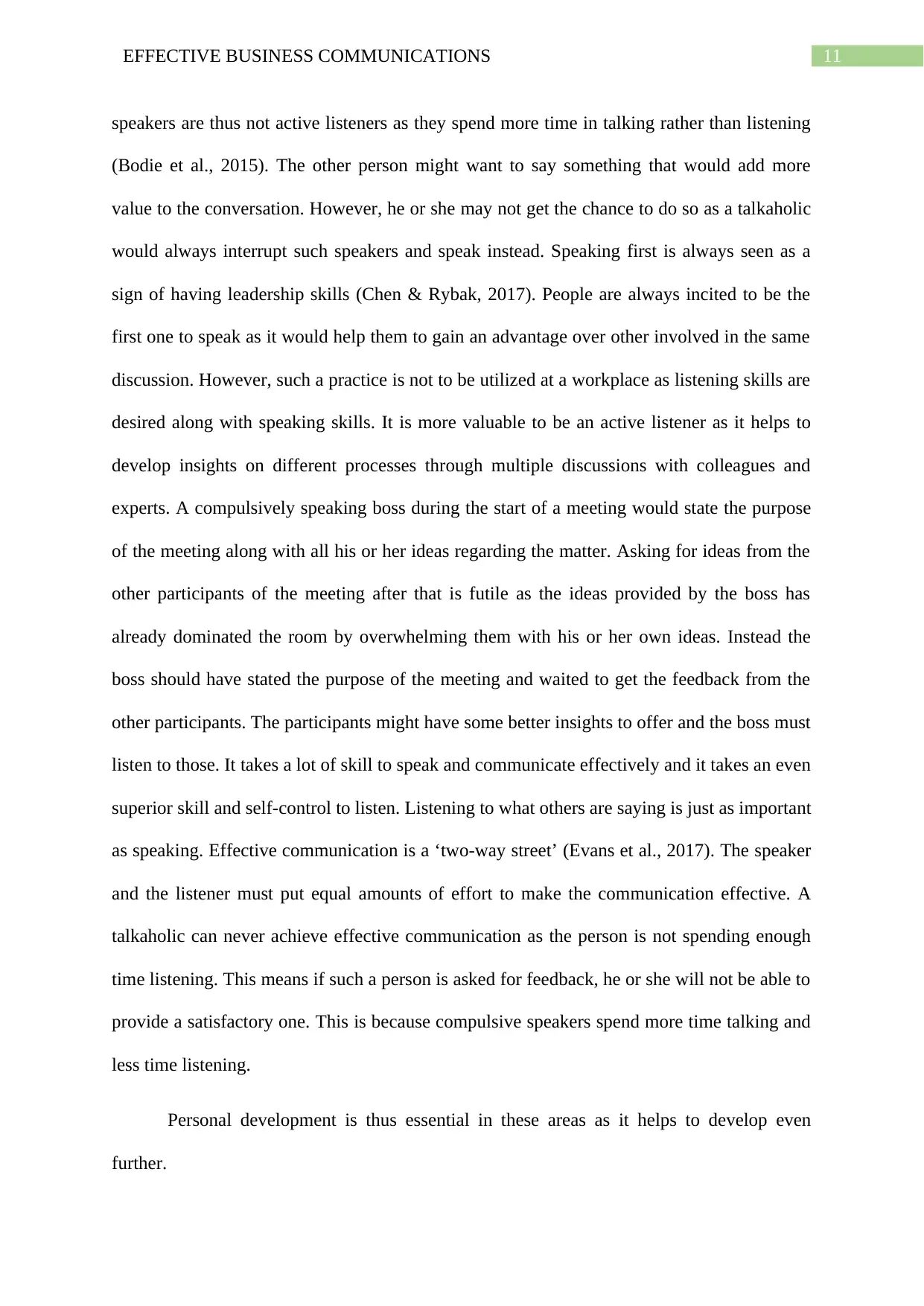
11EFFECTIVE BUSINESS COMMUNICATIONS
speakers are thus not active listeners as they spend more time in talking rather than listening
(Bodie et al., 2015). The other person might want to say something that would add more
value to the conversation. However, he or she may not get the chance to do so as a talkaholic
would always interrupt such speakers and speak instead. Speaking first is always seen as a
sign of having leadership skills (Chen & Rybak, 2017). People are always incited to be the
first one to speak as it would help them to gain an advantage over other involved in the same
discussion. However, such a practice is not to be utilized at a workplace as listening skills are
desired along with speaking skills. It is more valuable to be an active listener as it helps to
develop insights on different processes through multiple discussions with colleagues and
experts. A compulsively speaking boss during the start of a meeting would state the purpose
of the meeting along with all his or her ideas regarding the matter. Asking for ideas from the
other participants of the meeting after that is futile as the ideas provided by the boss has
already dominated the room by overwhelming them with his or her own ideas. Instead the
boss should have stated the purpose of the meeting and waited to get the feedback from the
other participants. The participants might have some better insights to offer and the boss must
listen to those. It takes a lot of skill to speak and communicate effectively and it takes an even
superior skill and self-control to listen. Listening to what others are saying is just as important
as speaking. Effective communication is a ‘two-way street’ (Evans et al., 2017). The speaker
and the listener must put equal amounts of effort to make the communication effective. A
talkaholic can never achieve effective communication as the person is not spending enough
time listening. This means if such a person is asked for feedback, he or she will not be able to
provide a satisfactory one. This is because compulsive speakers spend more time talking and
less time listening.
Personal development is thus essential in these areas as it helps to develop even
further.
speakers are thus not active listeners as they spend more time in talking rather than listening
(Bodie et al., 2015). The other person might want to say something that would add more
value to the conversation. However, he or she may not get the chance to do so as a talkaholic
would always interrupt such speakers and speak instead. Speaking first is always seen as a
sign of having leadership skills (Chen & Rybak, 2017). People are always incited to be the
first one to speak as it would help them to gain an advantage over other involved in the same
discussion. However, such a practice is not to be utilized at a workplace as listening skills are
desired along with speaking skills. It is more valuable to be an active listener as it helps to
develop insights on different processes through multiple discussions with colleagues and
experts. A compulsively speaking boss during the start of a meeting would state the purpose
of the meeting along with all his or her ideas regarding the matter. Asking for ideas from the
other participants of the meeting after that is futile as the ideas provided by the boss has
already dominated the room by overwhelming them with his or her own ideas. Instead the
boss should have stated the purpose of the meeting and waited to get the feedback from the
other participants. The participants might have some better insights to offer and the boss must
listen to those. It takes a lot of skill to speak and communicate effectively and it takes an even
superior skill and self-control to listen. Listening to what others are saying is just as important
as speaking. Effective communication is a ‘two-way street’ (Evans et al., 2017). The speaker
and the listener must put equal amounts of effort to make the communication effective. A
talkaholic can never achieve effective communication as the person is not spending enough
time listening. This means if such a person is asked for feedback, he or she will not be able to
provide a satisfactory one. This is because compulsive speakers spend more time talking and
less time listening.
Personal development is thus essential in these areas as it helps to develop even
further.

12EFFECTIVE BUSINESS COMMUNICATIONS
Paraphrase This Document
Need a fresh take? Get an instant paraphrase of this document with our AI Paraphraser

13EFFECTIVE BUSINESS COMMUNICATIONS
Action Plan
Knowledge, Skills and
Behaviours Required
Key Events and Activities Duration
Public Speaking skills that
includes leadership and
motivational skills
Masters in Public Speaking
Courses at Dale Carnegie
Training
From 24/1/2018 to 23/1/2020
Presentation skills Developing an effective idea
on what the presenting
publicly means
From 26/1/2018 to 28/1/2018
Planning and analysing skills Planning the speech and
learning about the
requirements of the speaker
From 29/1/2018 to 31/1/2018
Convincing skills Learning to make the
presentation convincing
From 1/2/2018 to 3/2/2018
Question and Answer skills Learning to handle questions
from the audience and
providing them with
appropriate answers.
From 4/2/2018 to 8/2/2018
Speaking accurately and
effectively
Understanding the talkaholic
scale and developing self for
better conversation
participation
From 9/2/2018 to 12/2/2018
Reflection Maintaining a journal that
could be used to reflect on
From 24/1/2018 to 23/7/2018
Action Plan
Knowledge, Skills and
Behaviours Required
Key Events and Activities Duration
Public Speaking skills that
includes leadership and
motivational skills
Masters in Public Speaking
Courses at Dale Carnegie
Training
From 24/1/2018 to 23/1/2020
Presentation skills Developing an effective idea
on what the presenting
publicly means
From 26/1/2018 to 28/1/2018
Planning and analysing skills Planning the speech and
learning about the
requirements of the speaker
From 29/1/2018 to 31/1/2018
Convincing skills Learning to make the
presentation convincing
From 1/2/2018 to 3/2/2018
Question and Answer skills Learning to handle questions
from the audience and
providing them with
appropriate answers.
From 4/2/2018 to 8/2/2018
Speaking accurately and
effectively
Understanding the talkaholic
scale and developing self for
better conversation
participation
From 9/2/2018 to 12/2/2018
Reflection Maintaining a journal that
could be used to reflect on
From 24/1/2018 to 23/7/2018
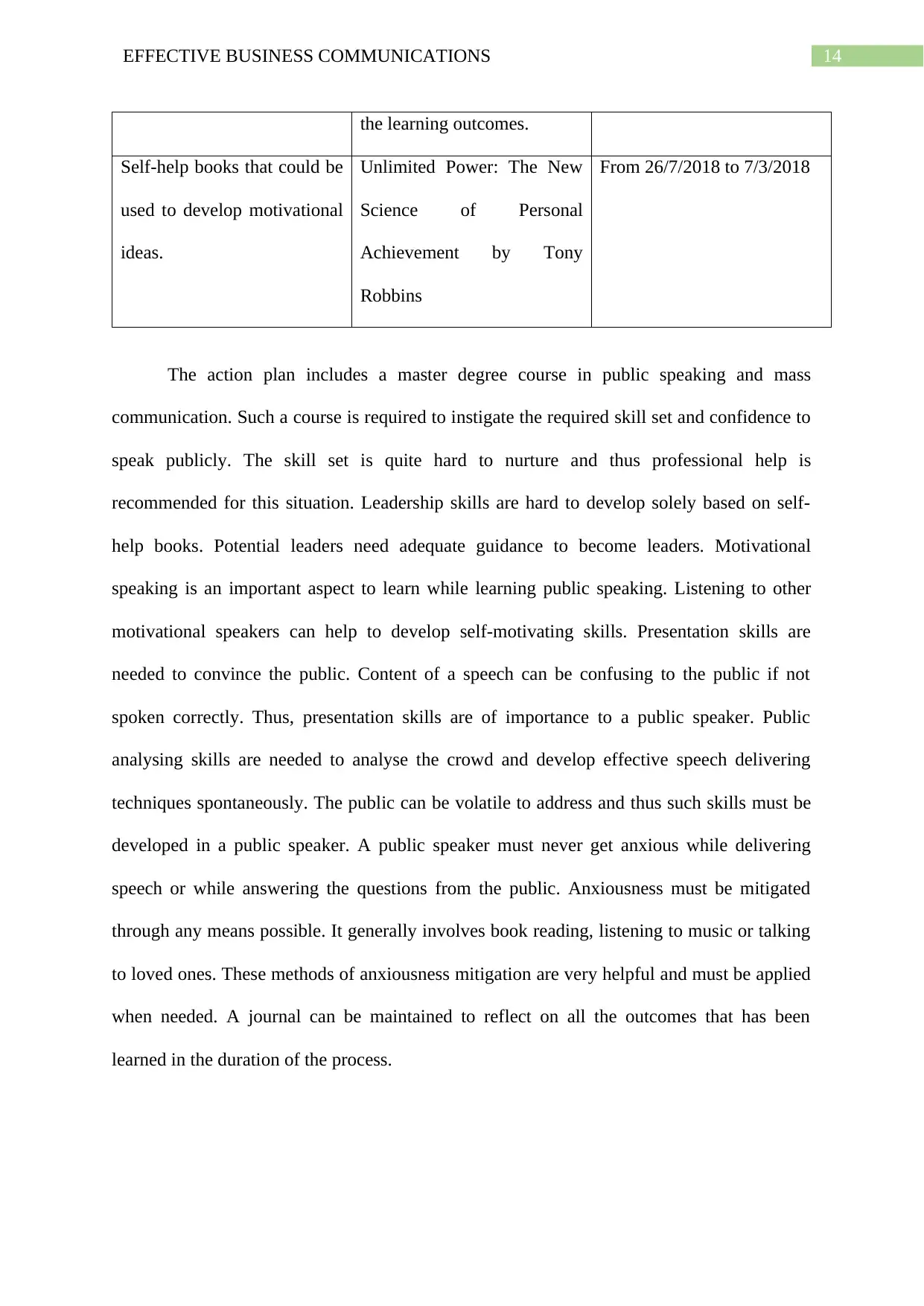
14EFFECTIVE BUSINESS COMMUNICATIONS
the learning outcomes.
Self-help books that could be
used to develop motivational
ideas.
Unlimited Power: The New
Science of Personal
Achievement by Tony
Robbins
From 26/7/2018 to 7/3/2018
The action plan includes a master degree course in public speaking and mass
communication. Such a course is required to instigate the required skill set and confidence to
speak publicly. The skill set is quite hard to nurture and thus professional help is
recommended for this situation. Leadership skills are hard to develop solely based on self-
help books. Potential leaders need adequate guidance to become leaders. Motivational
speaking is an important aspect to learn while learning public speaking. Listening to other
motivational speakers can help to develop self-motivating skills. Presentation skills are
needed to convince the public. Content of a speech can be confusing to the public if not
spoken correctly. Thus, presentation skills are of importance to a public speaker. Public
analysing skills are needed to analyse the crowd and develop effective speech delivering
techniques spontaneously. The public can be volatile to address and thus such skills must be
developed in a public speaker. A public speaker must never get anxious while delivering
speech or while answering the questions from the public. Anxiousness must be mitigated
through any means possible. It generally involves book reading, listening to music or talking
to loved ones. These methods of anxiousness mitigation are very helpful and must be applied
when needed. A journal can be maintained to reflect on all the outcomes that has been
learned in the duration of the process.
the learning outcomes.
Self-help books that could be
used to develop motivational
ideas.
Unlimited Power: The New
Science of Personal
Achievement by Tony
Robbins
From 26/7/2018 to 7/3/2018
The action plan includes a master degree course in public speaking and mass
communication. Such a course is required to instigate the required skill set and confidence to
speak publicly. The skill set is quite hard to nurture and thus professional help is
recommended for this situation. Leadership skills are hard to develop solely based on self-
help books. Potential leaders need adequate guidance to become leaders. Motivational
speaking is an important aspect to learn while learning public speaking. Listening to other
motivational speakers can help to develop self-motivating skills. Presentation skills are
needed to convince the public. Content of a speech can be confusing to the public if not
spoken correctly. Thus, presentation skills are of importance to a public speaker. Public
analysing skills are needed to analyse the crowd and develop effective speech delivering
techniques spontaneously. The public can be volatile to address and thus such skills must be
developed in a public speaker. A public speaker must never get anxious while delivering
speech or while answering the questions from the public. Anxiousness must be mitigated
through any means possible. It generally involves book reading, listening to music or talking
to loved ones. These methods of anxiousness mitigation are very helpful and must be applied
when needed. A journal can be maintained to reflect on all the outcomes that has been
learned in the duration of the process.
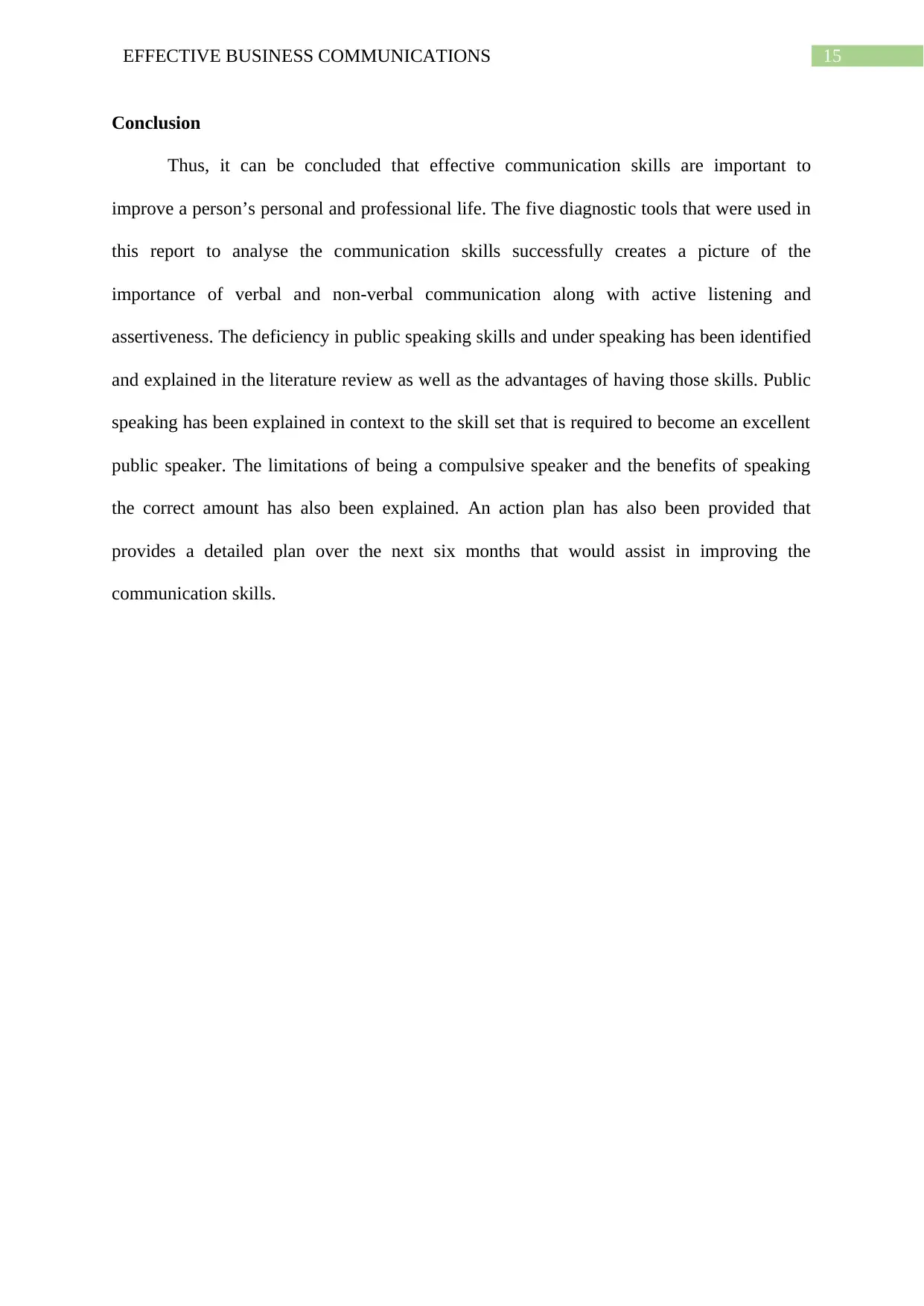
15EFFECTIVE BUSINESS COMMUNICATIONS
Conclusion
Thus, it can be concluded that effective communication skills are important to
improve a person’s personal and professional life. The five diagnostic tools that were used in
this report to analyse the communication skills successfully creates a picture of the
importance of verbal and non-verbal communication along with active listening and
assertiveness. The deficiency in public speaking skills and under speaking has been identified
and explained in the literature review as well as the advantages of having those skills. Public
speaking has been explained in context to the skill set that is required to become an excellent
public speaker. The limitations of being a compulsive speaker and the benefits of speaking
the correct amount has also been explained. An action plan has also been provided that
provides a detailed plan over the next six months that would assist in improving the
communication skills.
Conclusion
Thus, it can be concluded that effective communication skills are important to
improve a person’s personal and professional life. The five diagnostic tools that were used in
this report to analyse the communication skills successfully creates a picture of the
importance of verbal and non-verbal communication along with active listening and
assertiveness. The deficiency in public speaking skills and under speaking has been identified
and explained in the literature review as well as the advantages of having those skills. Public
speaking has been explained in context to the skill set that is required to become an excellent
public speaker. The limitations of being a compulsive speaker and the benefits of speaking
the correct amount has also been explained. An action plan has also been provided that
provides a detailed plan over the next six months that would assist in improving the
communication skills.
Secure Best Marks with AI Grader
Need help grading? Try our AI Grader for instant feedback on your assignments.

16EFFECTIVE BUSINESS COMMUNICATIONS
Reference List
Apostol-Mates, R., & Barbu, A. (2017). THE MILITARY BRIEFING-A TYPE OF
INFORMATIVE SPEECH. Scientific Bulletin" Mircea cel Batran" Naval
Academy, 20(1), 135.
Bodie, G. D., Vickery, A. J., Cannava, K., & Jones, S. M. (2015). The role of “active
listening” in informal helping conversations: Impact on perceptions of listener
helpfulness, sensitivity, and supportiveness and discloser emotional
improvement. Western Journal of Communication, 79(2), 151-173.
Burgoon, J. K., Guerrero, L. K., & Floyd, K. (2016). Nonverbal communication. Routledge.
Carlbring, P., Lindner, P., Miloff, A., Fagernäs, S., Andersen, J., Sigeman, M., ... &
Andersson, G. (2017). In session virtual reality use for public speaking anxiety: A
randomized controlled trial. In 9th Scientific Meeting of the International Society for
Research on Internet Interventions, Berlin, Germany, 12–14 October 2017. Elsevier.
Carnegie, D. (2017). How to develop self-confidence and influence people by public
speaking. Simon and Schuster.
Chen, L., Feng, G., Joe, J., Leong, C. W., Kitchen, C., & Lee, C. M. (2014, November).
Towards automated assessment of public speaking skills using multimodal cues.
In Proceedings of the 16th International Conference on Multimodal Interaction(pp.
200-203). ACM.
Chen, M. W., & Rybak, C. (2017). Group leadership skills: Interpersonal process in group
counseling and therapy. SAGE Publications.
Derman, P. B., Iyer, S., Garner, M., Orr, S., Felix, K. J., Goldberg, A., ... & Cornell, C.
(2016). An Initiative to Standardize the Identification of and Acute Response to
Reference List
Apostol-Mates, R., & Barbu, A. (2017). THE MILITARY BRIEFING-A TYPE OF
INFORMATIVE SPEECH. Scientific Bulletin" Mircea cel Batran" Naval
Academy, 20(1), 135.
Bodie, G. D., Vickery, A. J., Cannava, K., & Jones, S. M. (2015). The role of “active
listening” in informal helping conversations: Impact on perceptions of listener
helpfulness, sensitivity, and supportiveness and discloser emotional
improvement. Western Journal of Communication, 79(2), 151-173.
Burgoon, J. K., Guerrero, L. K., & Floyd, K. (2016). Nonverbal communication. Routledge.
Carlbring, P., Lindner, P., Miloff, A., Fagernäs, S., Andersen, J., Sigeman, M., ... &
Andersson, G. (2017). In session virtual reality use for public speaking anxiety: A
randomized controlled trial. In 9th Scientific Meeting of the International Society for
Research on Internet Interventions, Berlin, Germany, 12–14 October 2017. Elsevier.
Carnegie, D. (2017). How to develop self-confidence and influence people by public
speaking. Simon and Schuster.
Chen, L., Feng, G., Joe, J., Leong, C. W., Kitchen, C., & Lee, C. M. (2014, November).
Towards automated assessment of public speaking skills using multimodal cues.
In Proceedings of the 16th International Conference on Multimodal Interaction(pp.
200-203). ACM.
Chen, M. W., & Rybak, C. (2017). Group leadership skills: Interpersonal process in group
counseling and therapy. SAGE Publications.
Derman, P. B., Iyer, S., Garner, M., Orr, S., Felix, K. J., Goldberg, A., ... & Cornell, C.
(2016). An Initiative to Standardize the Identification of and Acute Response to
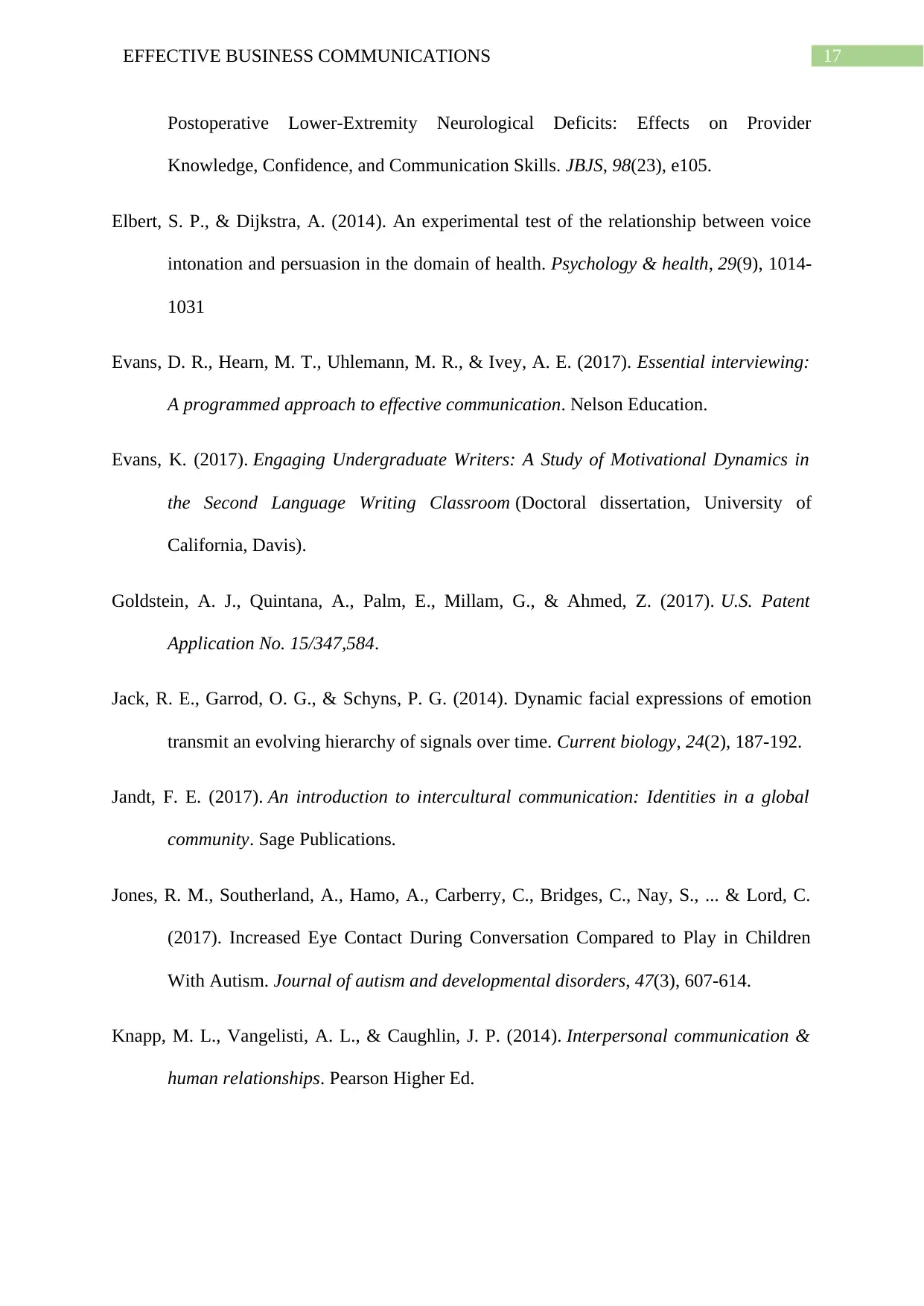
17EFFECTIVE BUSINESS COMMUNICATIONS
Postoperative Lower-Extremity Neurological Deficits: Effects on Provider
Knowledge, Confidence, and Communication Skills. JBJS, 98(23), e105.
Elbert, S. P., & Dijkstra, A. (2014). An experimental test of the relationship between voice
intonation and persuasion in the domain of health. Psychology & health, 29(9), 1014-
1031
Evans, D. R., Hearn, M. T., Uhlemann, M. R., & Ivey, A. E. (2017). Essential interviewing:
A programmed approach to effective communication. Nelson Education.
Evans, K. (2017). Engaging Undergraduate Writers: A Study of Motivational Dynamics in
the Second Language Writing Classroom (Doctoral dissertation, University of
California, Davis).
Goldstein, A. J., Quintana, A., Palm, E., Millam, G., & Ahmed, Z. (2017). U.S. Patent
Application No. 15/347,584.
Jack, R. E., Garrod, O. G., & Schyns, P. G. (2014). Dynamic facial expressions of emotion
transmit an evolving hierarchy of signals over time. Current biology, 24(2), 187-192.
Jandt, F. E. (2017). An introduction to intercultural communication: Identities in a global
community. Sage Publications.
Jones, R. M., Southerland, A., Hamo, A., Carberry, C., Bridges, C., Nay, S., ... & Lord, C.
(2017). Increased Eye Contact During Conversation Compared to Play in Children
With Autism. Journal of autism and developmental disorders, 47(3), 607-614.
Knapp, M. L., Vangelisti, A. L., & Caughlin, J. P. (2014). Interpersonal communication &
human relationships. Pearson Higher Ed.
Postoperative Lower-Extremity Neurological Deficits: Effects on Provider
Knowledge, Confidence, and Communication Skills. JBJS, 98(23), e105.
Elbert, S. P., & Dijkstra, A. (2014). An experimental test of the relationship between voice
intonation and persuasion in the domain of health. Psychology & health, 29(9), 1014-
1031
Evans, D. R., Hearn, M. T., Uhlemann, M. R., & Ivey, A. E. (2017). Essential interviewing:
A programmed approach to effective communication. Nelson Education.
Evans, K. (2017). Engaging Undergraduate Writers: A Study of Motivational Dynamics in
the Second Language Writing Classroom (Doctoral dissertation, University of
California, Davis).
Goldstein, A. J., Quintana, A., Palm, E., Millam, G., & Ahmed, Z. (2017). U.S. Patent
Application No. 15/347,584.
Jack, R. E., Garrod, O. G., & Schyns, P. G. (2014). Dynamic facial expressions of emotion
transmit an evolving hierarchy of signals over time. Current biology, 24(2), 187-192.
Jandt, F. E. (2017). An introduction to intercultural communication: Identities in a global
community. Sage Publications.
Jones, R. M., Southerland, A., Hamo, A., Carberry, C., Bridges, C., Nay, S., ... & Lord, C.
(2017). Increased Eye Contact During Conversation Compared to Play in Children
With Autism. Journal of autism and developmental disorders, 47(3), 607-614.
Knapp, M. L., Vangelisti, A. L., & Caughlin, J. P. (2014). Interpersonal communication &
human relationships. Pearson Higher Ed.

18EFFECTIVE BUSINESS COMMUNICATIONS
Koegel, L. K., Ashbaugh, K., Navab, A., & Koegel, R. L. (2016). Improving empathic
communication skills in adults with autism spectrum disorder. Journal of autism and
developmental disorders, 46(3), 921-933.
Li, G. (2014). Information sharing and stock market participation: Evidence from extended
families. Review of Economics and Statistics, 96(1), 151-160.
Mawson, A. R. (2017). Mass panic and social attachment: The dynamics of human behavior.
Routledge.
Meyer, R., Dennis, J., Markus, H., & Boxenbaum, E. (2014). From idea to organizational
practice: Institutionalizing innovative ideas through visualization (No. hal-
01103137).
Nakai, Y., Takashima, R., Takiguchi, T., & Takada, S. (2014). Speech intonation in children
with autism spectrum disorder. Brain and Development, 36(6), 516-522.
Neuliep, J. W. (2017). Intercultural communication: A contextual approach. Sage
Publications.
Pease, A., & Pease, B. (2016). The Definitive Book of Body Language: how to read others’
attitudes by their gestures. Hachette UK.
Shahbaz, M., Khan, M. S., Khan, R. M. I., & Mustafa, G. (2016). Role of self-perceived
communication competence and communication apprehension for willingness to
communicate in L1 and L2. Journal of Educational and Social Research, 6(1), 158.
Sidelinger, R. J., & Bolen, D. M. (2015). Compulsive Communication in the Classroom: Is
the Talkaholic Teacher a Misbehaving Instructor?. Western Journal of
Communication, 79(2), 174-196.
Koegel, L. K., Ashbaugh, K., Navab, A., & Koegel, R. L. (2016). Improving empathic
communication skills in adults with autism spectrum disorder. Journal of autism and
developmental disorders, 46(3), 921-933.
Li, G. (2014). Information sharing and stock market participation: Evidence from extended
families. Review of Economics and Statistics, 96(1), 151-160.
Mawson, A. R. (2017). Mass panic and social attachment: The dynamics of human behavior.
Routledge.
Meyer, R., Dennis, J., Markus, H., & Boxenbaum, E. (2014). From idea to organizational
practice: Institutionalizing innovative ideas through visualization (No. hal-
01103137).
Nakai, Y., Takashima, R., Takiguchi, T., & Takada, S. (2014). Speech intonation in children
with autism spectrum disorder. Brain and Development, 36(6), 516-522.
Neuliep, J. W. (2017). Intercultural communication: A contextual approach. Sage
Publications.
Pease, A., & Pease, B. (2016). The Definitive Book of Body Language: how to read others’
attitudes by their gestures. Hachette UK.
Shahbaz, M., Khan, M. S., Khan, R. M. I., & Mustafa, G. (2016). Role of self-perceived
communication competence and communication apprehension for willingness to
communicate in L1 and L2. Journal of Educational and Social Research, 6(1), 158.
Sidelinger, R. J., & Bolen, D. M. (2015). Compulsive Communication in the Classroom: Is
the Talkaholic Teacher a Misbehaving Instructor?. Western Journal of
Communication, 79(2), 174-196.
Paraphrase This Document
Need a fresh take? Get an instant paraphrase of this document with our AI Paraphraser
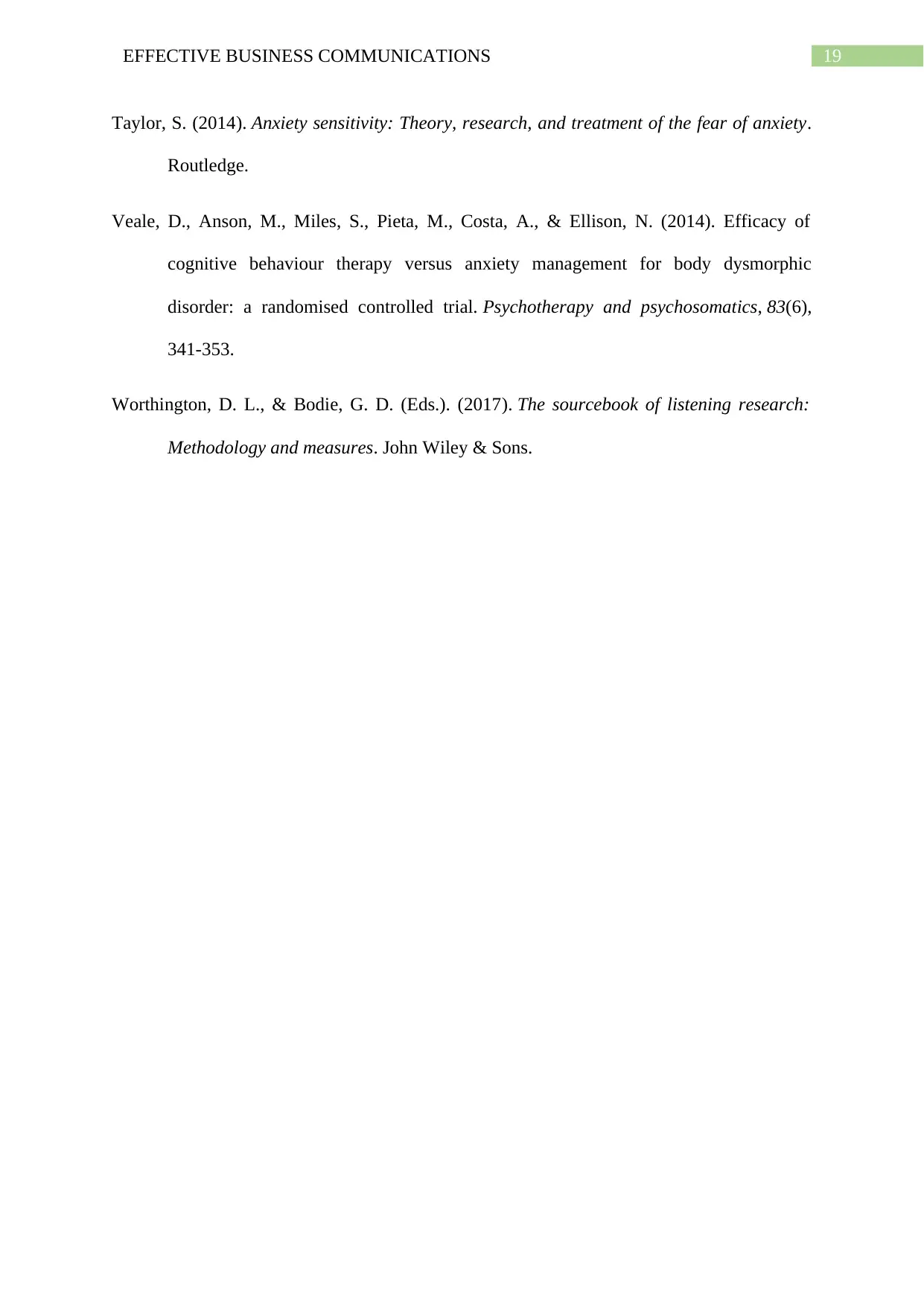
19EFFECTIVE BUSINESS COMMUNICATIONS
Taylor, S. (2014). Anxiety sensitivity: Theory, research, and treatment of the fear of anxiety.
Routledge.
Veale, D., Anson, M., Miles, S., Pieta, M., Costa, A., & Ellison, N. (2014). Efficacy of
cognitive behaviour therapy versus anxiety management for body dysmorphic
disorder: a randomised controlled trial. Psychotherapy and psychosomatics, 83(6),
341-353.
Worthington, D. L., & Bodie, G. D. (Eds.). (2017). The sourcebook of listening research:
Methodology and measures. John Wiley & Sons.
Taylor, S. (2014). Anxiety sensitivity: Theory, research, and treatment of the fear of anxiety.
Routledge.
Veale, D., Anson, M., Miles, S., Pieta, M., Costa, A., & Ellison, N. (2014). Efficacy of
cognitive behaviour therapy versus anxiety management for body dysmorphic
disorder: a randomised controlled trial. Psychotherapy and psychosomatics, 83(6),
341-353.
Worthington, D. L., & Bodie, G. D. (Eds.). (2017). The sourcebook of listening research:
Methodology and measures. John Wiley & Sons.
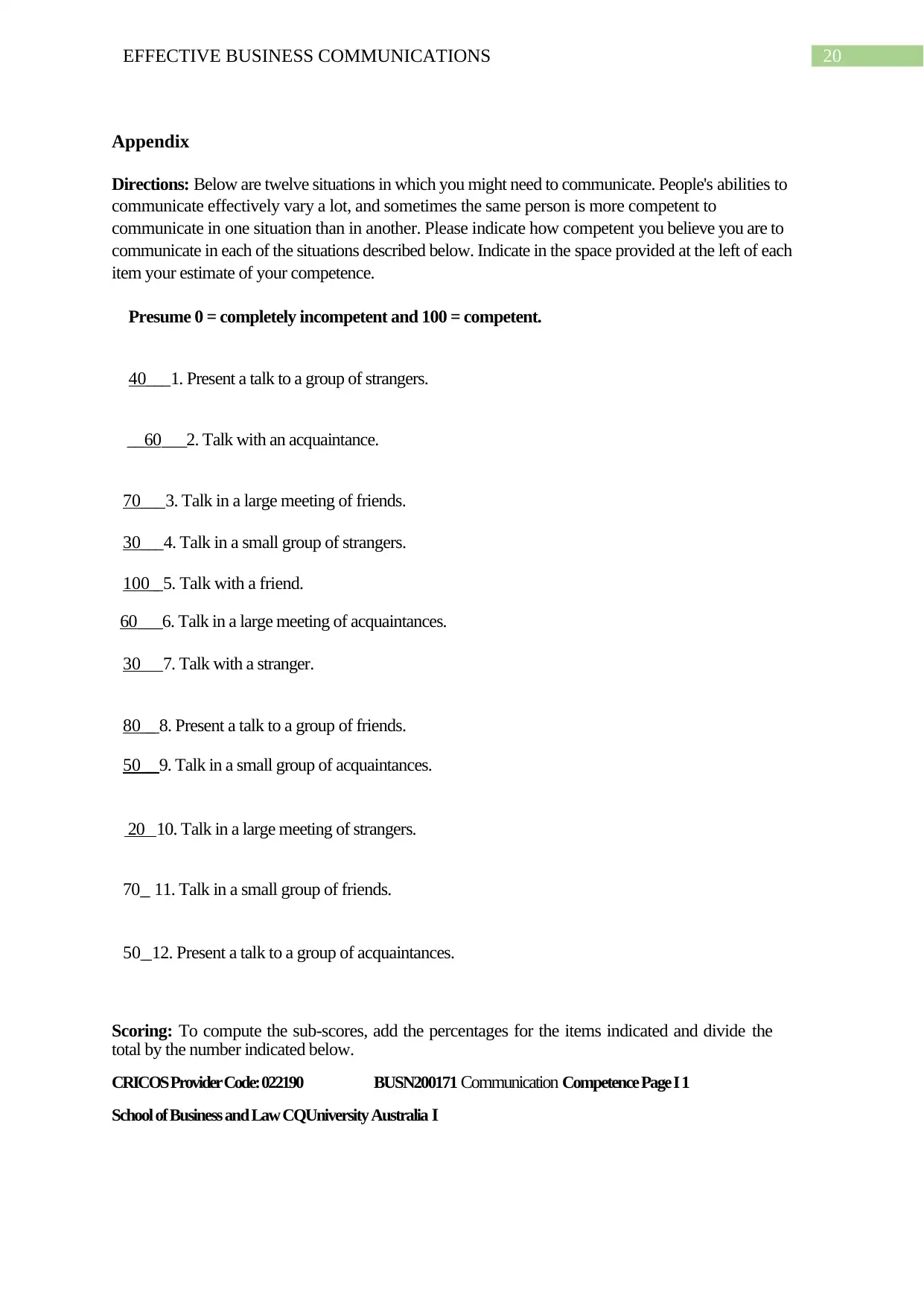
20EFFECTIVE BUSINESS COMMUNICATIONS
Appendix
Directions: Below are twelve situations in which you might need to communicate. People's abilities to
communicate effectively vary a lot, and sometimes the same person is more competent to
communicate in one situation than in another. Please indicate how competent you believe you are to
communicate in each of the situations described below. Indicate in the space provided at the left of each
item your estimate of your competence.
Presume 0 = completely incompetent and 100 = competent.
40___1. Present a talk to a group of strangers.
__60___2. Talk with an acquaintance.
70___3. Talk in a large meeting of friends.
30___4. Talk in a small group of strangers.
100__5. Talk with a friend.
60___6. Talk in a large meeting of acquaintances.
30 7. Talk with a stranger.
80___8. Present a talk to a group of friends.
50___9. Talk in a small group of acquaintances.
20 10. Talk in a large meeting of strangers.
70__ 11. Talk in a small group of friends.
50__12. Present a talk to a group of acquaintances.
Scoring: To compute the sub-scores, add the percentages for the items indicated and divide the
total by the number indicated below.
CRICOS Provider Code: 022190 BUSN200171 Communication Competence Page I 1
School of Business and Law CQUniversity Australia I
Appendix
Directions: Below are twelve situations in which you might need to communicate. People's abilities to
communicate effectively vary a lot, and sometimes the same person is more competent to
communicate in one situation than in another. Please indicate how competent you believe you are to
communicate in each of the situations described below. Indicate in the space provided at the left of each
item your estimate of your competence.
Presume 0 = completely incompetent and 100 = competent.
40___1. Present a talk to a group of strangers.
__60___2. Talk with an acquaintance.
70___3. Talk in a large meeting of friends.
30___4. Talk in a small group of strangers.
100__5. Talk with a friend.
60___6. Talk in a large meeting of acquaintances.
30 7. Talk with a stranger.
80___8. Present a talk to a group of friends.
50___9. Talk in a small group of acquaintances.
20 10. Talk in a large meeting of strangers.
70__ 11. Talk in a small group of friends.
50__12. Present a talk to a group of acquaintances.
Scoring: To compute the sub-scores, add the percentages for the items indicated and divide the
total by the number indicated below.
CRICOS Provider Code: 022190 BUSN200171 Communication Competence Page I 1
School of Business and Law CQUniversity Australia I
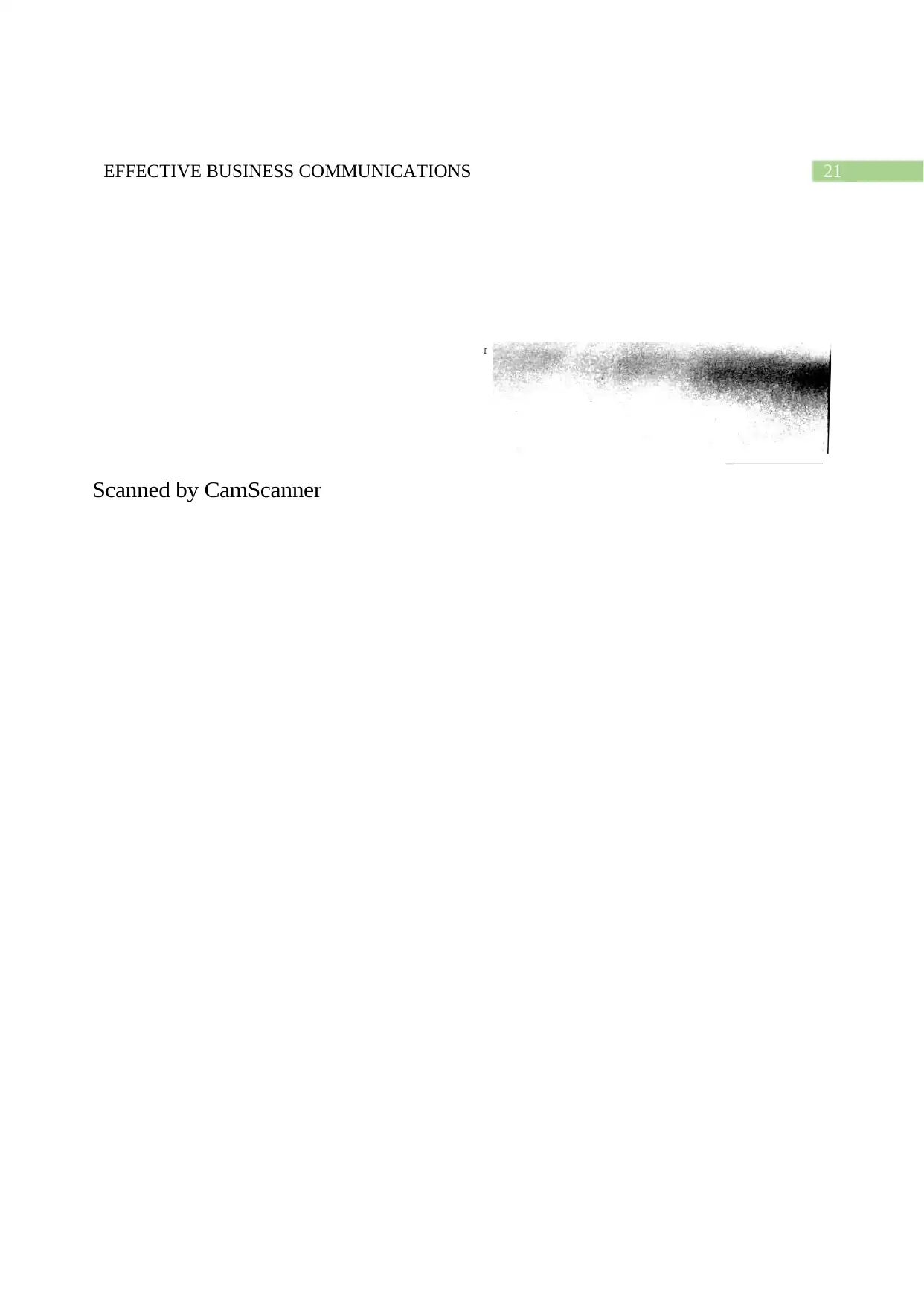
r.
21EFFECTIVE BUSINESS COMMUNICATIONS
Scanned by CamScanner
21EFFECTIVE BUSINESS COMMUNICATIONS
Scanned by CamScanner
Secure Best Marks with AI Grader
Need help grading? Try our AI Grader for instant feedback on your assignments.
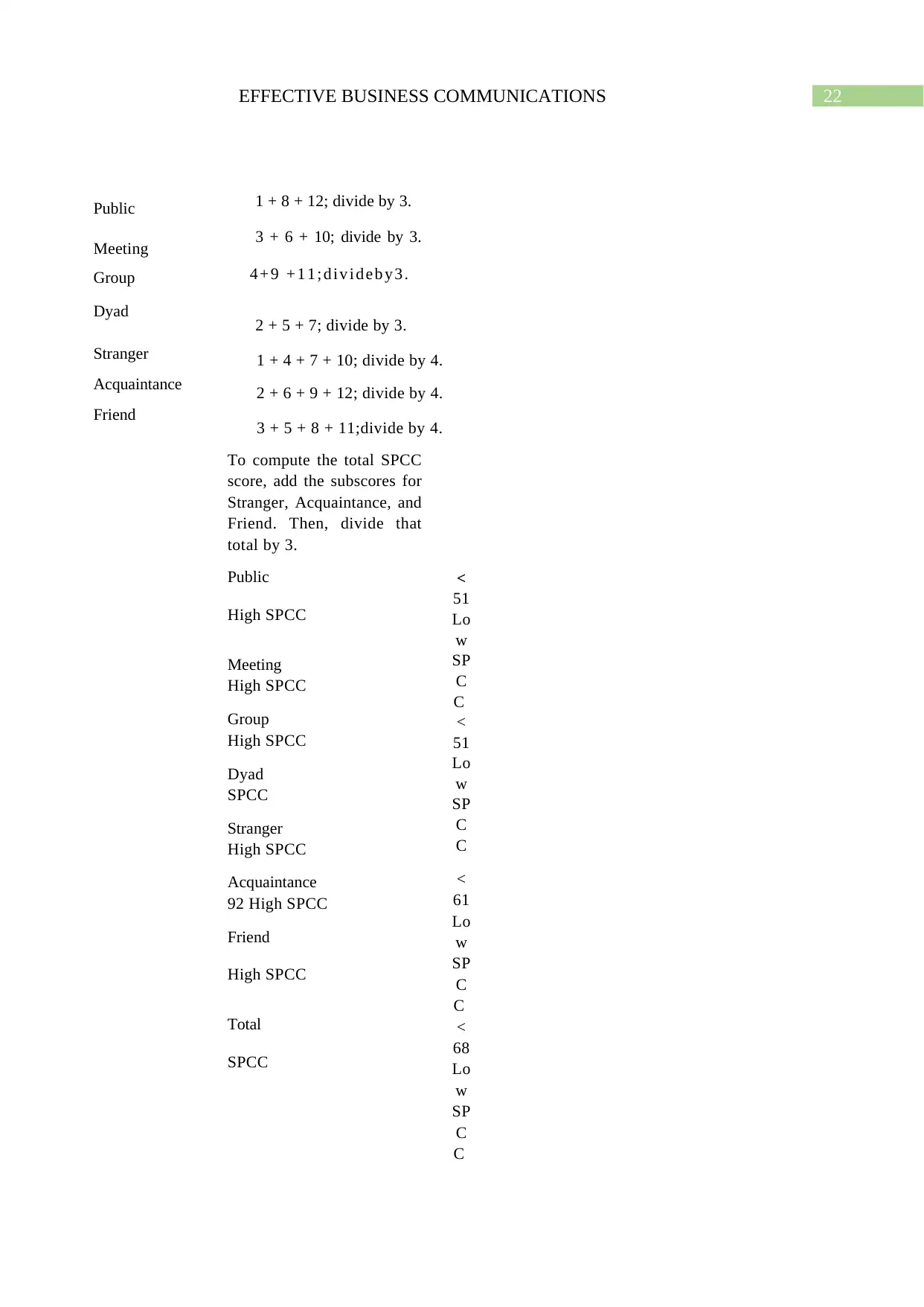
22EFFECTIVE BUSINESS COMMUNICATIONS
1 + 8 + 12; divide by 3.
3 + 6 + 10; divide by 3.
4 + 9 + 1 1 ; d i v i d e b y 3 .
2 + 5 + 7; divide by 3.
1 + 4 + 7 + 10; divide by 4.
2 + 6 + 9 + 12; divide by 4.
3 + 5 + 8 + 11;divide by 4.
To compute the total SPCC
score, add the subscores for
Stranger, Acquaintance, and
Friend. Then, divide that
total by 3.
Public
High SPCC
Meeting
High SPCC
Group
High SPCC
Dyad
SPCC
Stranger
High SPCC
Acquaintance
92 High SPCC
Friend
High SPCC
Total
SPCC
<
51
Lo
w
SP
C
C
<
51
Lo
w
SP
C
C
<
61
Lo
w
SP
C
C
<
68
Lo
w
SP
C
C
Public
Meeting
Group
Dyad
Stranger
Acquaintance
Friend
1 + 8 + 12; divide by 3.
3 + 6 + 10; divide by 3.
4 + 9 + 1 1 ; d i v i d e b y 3 .
2 + 5 + 7; divide by 3.
1 + 4 + 7 + 10; divide by 4.
2 + 6 + 9 + 12; divide by 4.
3 + 5 + 8 + 11;divide by 4.
To compute the total SPCC
score, add the subscores for
Stranger, Acquaintance, and
Friend. Then, divide that
total by 3.
Public
High SPCC
Meeting
High SPCC
Group
High SPCC
Dyad
SPCC
Stranger
High SPCC
Acquaintance
92 High SPCC
Friend
High SPCC
Total
SPCC
<
51
Lo
w
SP
C
C
<
51
Lo
w
SP
C
C
<
61
Lo
w
SP
C
C
<
68
Lo
w
SP
C
C
Public
Meeting
Group
Dyad
Stranger
Acquaintance
Friend
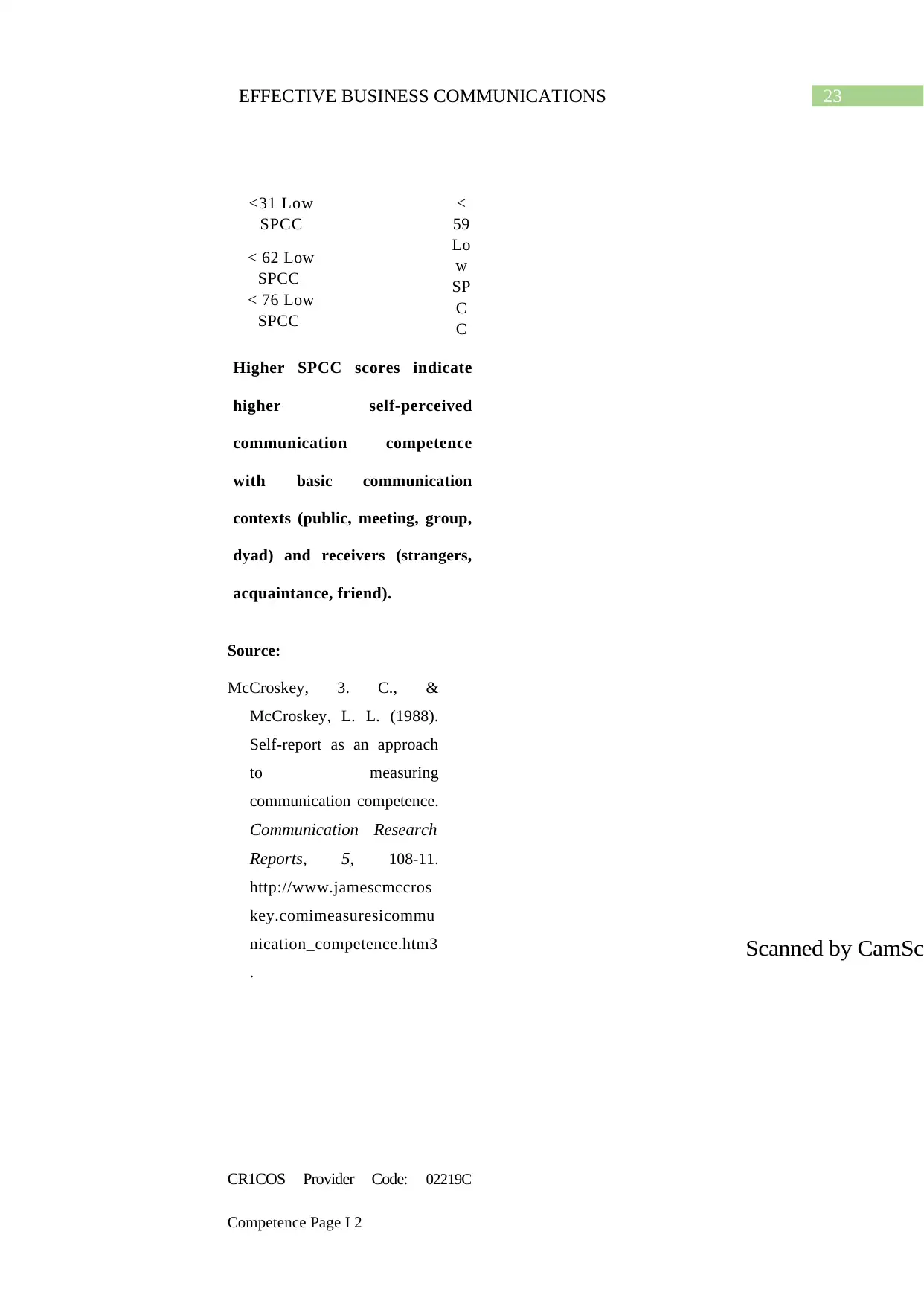
23EFFECTIVE BUSINESS COMMUNICATIONS
<31 Low
SPCC
< 62 Low
SPCC
< 76 Low
SPCC
<
59
Lo
w
SP
C
C
Higher SPCC scores indicate
higher self-perceived
communication competence
with basic communication
contexts (public, meeting, group,
dyad) and receivers (strangers,
acquaintance, friend).
Source:
McCroskey, 3. C., &
McCroskey, L. L. (1988).
Self-report as an approach
to measuring
communication competence.
Communication Research
Reports, 5, 108-11.
http://www.jamescmccros
key.comimeasuresicommu
nication_competence.htm3
.
CR1COS Provider Code: 02219C
Competence Page I 2
Scanned by CamSc
<31 Low
SPCC
< 62 Low
SPCC
< 76 Low
SPCC
<
59
Lo
w
SP
C
C
Higher SPCC scores indicate
higher self-perceived
communication competence
with basic communication
contexts (public, meeting, group,
dyad) and receivers (strangers,
acquaintance, friend).
Source:
McCroskey, 3. C., &
McCroskey, L. L. (1988).
Self-report as an approach
to measuring
communication competence.
Communication Research
Reports, 5, 108-11.
http://www.jamescmccros
key.comimeasuresicommu
nication_competence.htm3
.
CR1COS Provider Code: 02219C
Competence Page I 2
Scanned by CamSc

24EFFECTIVE BUSINESS COMMUNICATIONS
School of Business and Law
CQUniversity Australia I
School of Business and Law
CQUniversity Australia I
Paraphrase This Document
Need a fresh take? Get an instant paraphrase of this document with our AI Paraphraser
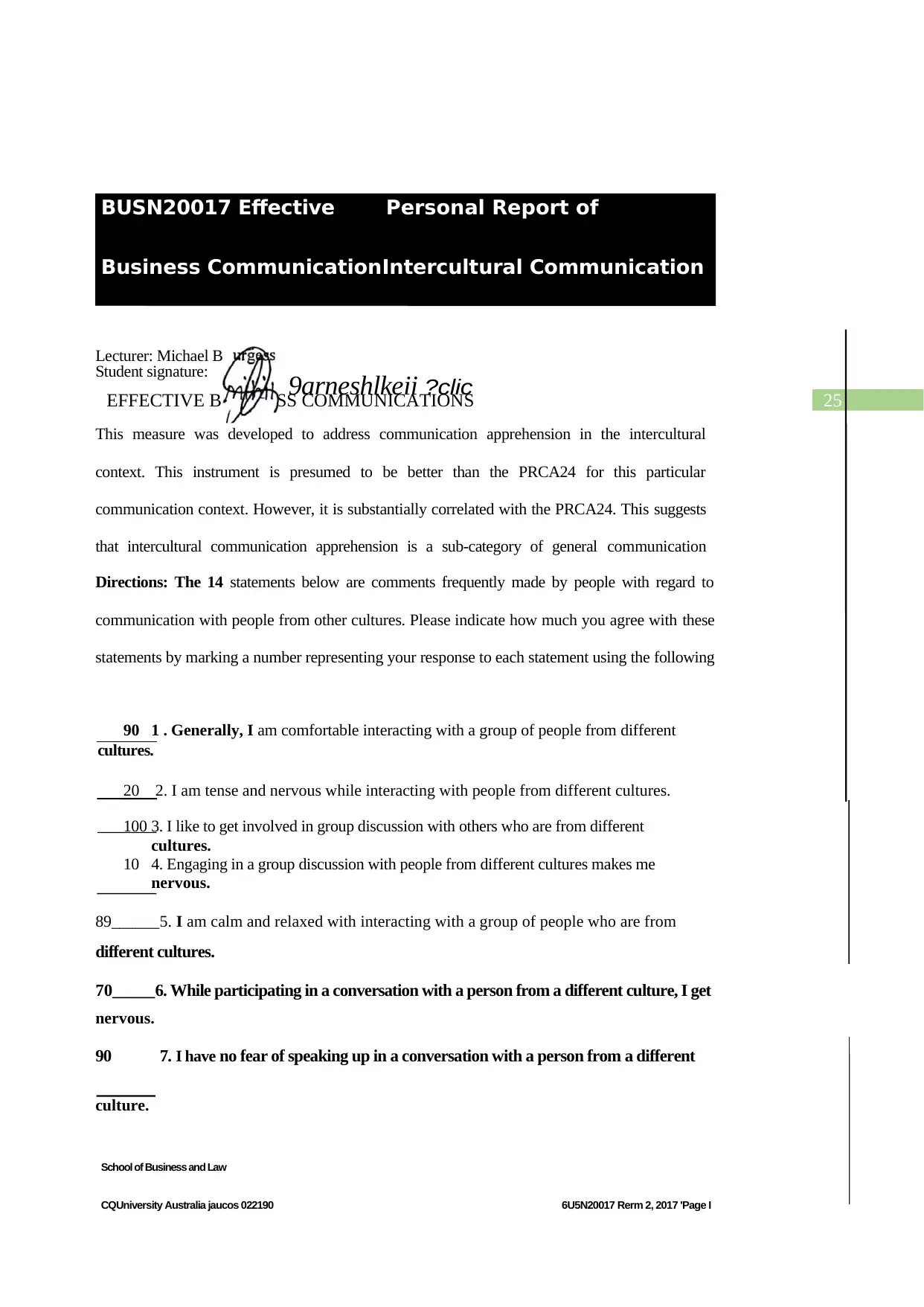
25EFFECTIVE BUSINESS COMMUNICATIONS
100 3. I like to get involved in group discussion with others who are from different
cultures.
10 4. Engaging in a group discussion with people from different cultures makes me
nervous.
89______5. I am calm and relaxed with interacting with a group of people who are from
different cultures.
70_____6. While participating in a conversation with a person from a different culture, I get
nervous.
90 7. I have no fear of speaking up in a conversation with a person from a different
culture.
School of Business and Law
CQUniversity Australia jaucos 022190 6U5N20017 Rerm 2, 2017 'Page I
BUSN20017 Effective Personal Report of
Business CommunicationIntercultural Communication
Lecturer: Michael B
Student signature:
9arneshlkeii ?clic
This measure was developed to address communication apprehension in the intercultural
context. This instrument is presumed to be better than the PRCA24 for this particular
communication context. However, it is substantially correlated with the PRCA24. This suggests
that intercultural communication apprehension is a sub-category of general communication
apprehension. Alpha reliability estimates should be expected to be above .90 when completedDirections: The 14 statements below are comments frequently made by people with regard to
communication with people from other cultures. Please indicate how much you agree with these
statements by marking a number representing your response to each statement using the following
choices: Strongly Disagree = 1; Disagree = 2; are Neutral = 3; Agree = 4; Strongly Agree = 5
90 1 . Generally, I am comfortable interacting with a group of people from different
cultures.
20 2. I am tense and nervous while interacting with people from different cultures.
100 3. I like to get involved in group discussion with others who are from different
cultures.
10 4. Engaging in a group discussion with people from different cultures makes me
nervous.
89______5. I am calm and relaxed with interacting with a group of people who are from
different cultures.
70_____6. While participating in a conversation with a person from a different culture, I get
nervous.
90 7. I have no fear of speaking up in a conversation with a person from a different
culture.
School of Business and Law
CQUniversity Australia jaucos 022190 6U5N20017 Rerm 2, 2017 'Page I
BUSN20017 Effective Personal Report of
Business CommunicationIntercultural Communication
Lecturer: Michael B
Student signature:
9arneshlkeii ?clic
This measure was developed to address communication apprehension in the intercultural
context. This instrument is presumed to be better than the PRCA24 for this particular
communication context. However, it is substantially correlated with the PRCA24. This suggests
that intercultural communication apprehension is a sub-category of general communication
apprehension. Alpha reliability estimates should be expected to be above .90 when completedDirections: The 14 statements below are comments frequently made by people with regard to
communication with people from other cultures. Please indicate how much you agree with these
statements by marking a number representing your response to each statement using the following
choices: Strongly Disagree = 1; Disagree = 2; are Neutral = 3; Agree = 4; Strongly Agree = 5
90 1 . Generally, I am comfortable interacting with a group of people from different
cultures.
20 2. I am tense and nervous while interacting with people from different cultures.
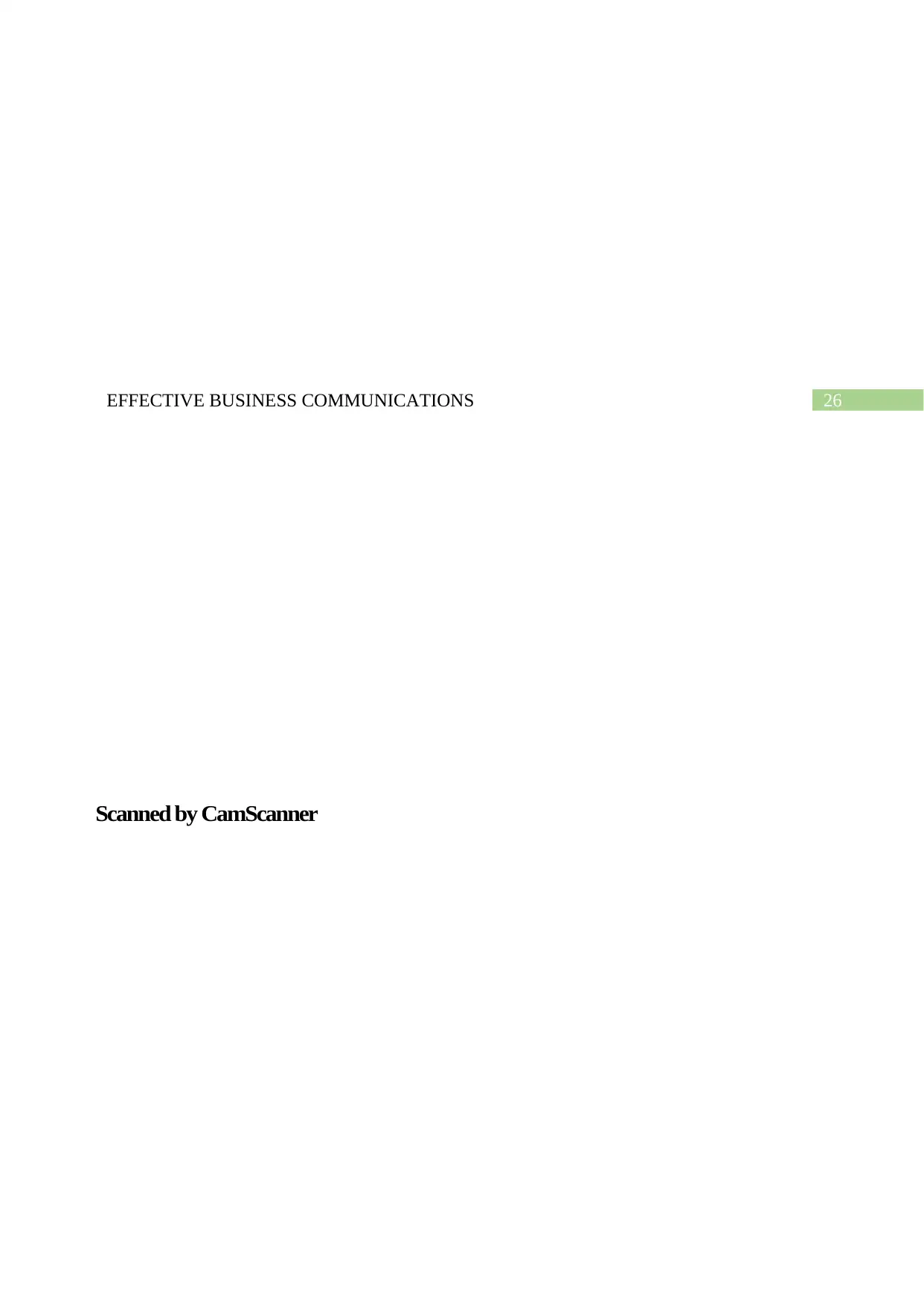
26EFFECTIVE BUSINESS COMMUNICATIONS
Scanned by CamScanner
Scanned by CamScanner

27EFFECTIVE BUSINESS COMMUNICATIONS
10______8. Ordinarily I am very tense and nervous in a conversation with person from a
different culture.
80_____9. Ordinarily I am very calm and relaxed in conversations with a person from a
different culture.
100____10. While conversing with a person from a different culture, I feel very relaxed.
0______11. I am afraid to speak up in conversations with a person from a different culture.
80_____12.1 face the prospect of interacting with people from different cultures with
confidence.
10_____13. My thoughts become confused and jumbled when interacting with people from
different cultures.
0_______14. Communicating with people from different cultures makes me feel
uncomfortable.
Scoring: To compute the PRICA score, complete the following steps:
Step 1. Add the scores for the following items: 1, 3, 5, 7, 9, 10, and 12
Step 2. Add the scores for the following items: 2, 4, 6, 8, 11, 13, and 14
Step 3. Complete the following formula: PRICA score = 42 - Total from Step 1 + Total from
Step 2.
Scores can range from 14 to 70. Scores below 32 indicate low intercultural CA. Scores above
52 indicate high intercultural CA. Scores ranging between 32 and 52 indicate a moderate
level of intercultural CA.
Source:
Neuliep, J. W., & McCroskey, J. C. (1997). The development of intercultural and interethnic
communication apprehension scales. Communication Research Reports, 14, 385-398.
Scanned by CamScanner
10______8. Ordinarily I am very tense and nervous in a conversation with person from a
different culture.
80_____9. Ordinarily I am very calm and relaxed in conversations with a person from a
different culture.
100____10. While conversing with a person from a different culture, I feel very relaxed.
0______11. I am afraid to speak up in conversations with a person from a different culture.
80_____12.1 face the prospect of interacting with people from different cultures with
confidence.
10_____13. My thoughts become confused and jumbled when interacting with people from
different cultures.
0_______14. Communicating with people from different cultures makes me feel
uncomfortable.
Scoring: To compute the PRICA score, complete the following steps:
Step 1. Add the scores for the following items: 1, 3, 5, 7, 9, 10, and 12
Step 2. Add the scores for the following items: 2, 4, 6, 8, 11, 13, and 14
Step 3. Complete the following formula: PRICA score = 42 - Total from Step 1 + Total from
Step 2.
Scores can range from 14 to 70. Scores below 32 indicate low intercultural CA. Scores above
52 indicate high intercultural CA. Scores ranging between 32 and 52 indicate a moderate
level of intercultural CA.
Source:
Neuliep, J. W., & McCroskey, J. C. (1997). The development of intercultural and interethnic
communication apprehension scales. Communication Research Reports, 14, 385-398.
Scanned by CamScanner
Secure Best Marks with AI Grader
Need help grading? Try our AI Grader for instant feedback on your assignments.

28EFFECTIVE BUSINESS COMMUNICATIONS
School of Business and Law
CQUnlversIty Australia I CAICOS 02219C BUSN20017 'Term 2, 2017 page 2
School of Business and Law
CQUnlversIty Australia I CAICOS 02219C BUSN20017 'Term 2, 2017 page 2
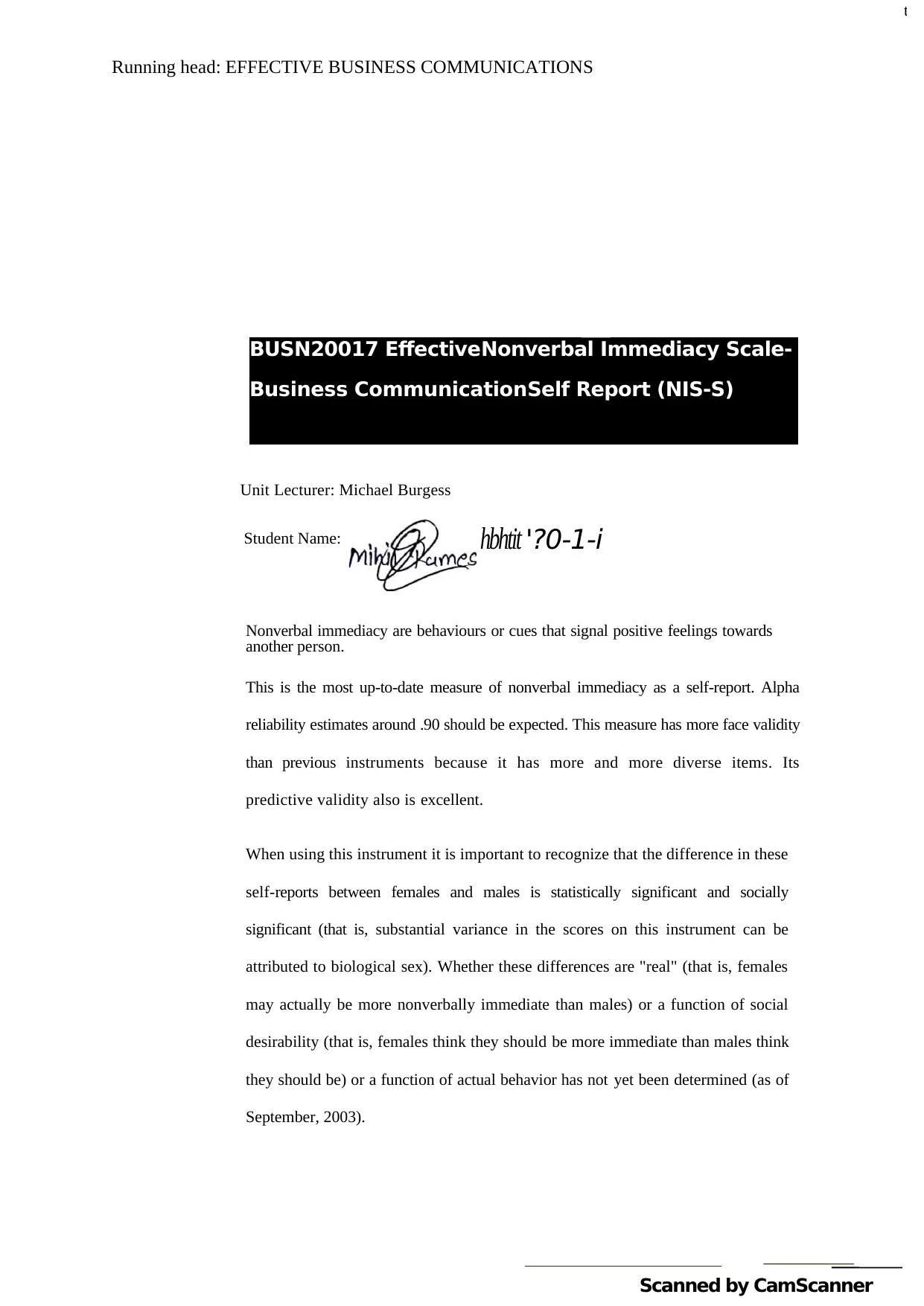
Running head: EFFECTIVE BUSINESS COMMUNICATIONS
BUSN20017 EffectiveNonverbal Immediacy Scale-
Business CommunicationSelf Report (NIS-S)
Unit Lecturer: Michael Burgess
Student Name: hbhtit '?0-1-i
Nonverbal immediacy are behaviours or cues that signal positive feelings towards
another person.
This is the most up-to-date measure of nonverbal immediacy as a self-report. Alpha
reliability estimates around .90 should be expected. This measure has more face validity
than previous instruments because it has more and more diverse items. Its
predictive validity also is excellent.
When using this instrument it is important to recognize that the difference in these
self-reports between females and males is statistically significant and socially
significant (that is, substantial variance in the scores on this instrument can be
attributed to biological sex). Whether these differences are "real" (that is, females
may actually be more nonverbally immediate than males) or a function of social
desirability (that is, females think they should be more immediate than males think
they should be) or a function of actual behavior has not yet been determined (as of
September, 2003).
Scanned by CamScanner
t
BUSN20017 EffectiveNonverbal Immediacy Scale-
Business CommunicationSelf Report (NIS-S)
Unit Lecturer: Michael Burgess
Student Name: hbhtit '?0-1-i
Nonverbal immediacy are behaviours or cues that signal positive feelings towards
another person.
This is the most up-to-date measure of nonverbal immediacy as a self-report. Alpha
reliability estimates around .90 should be expected. This measure has more face validity
than previous instruments because it has more and more diverse items. Its
predictive validity also is excellent.
When using this instrument it is important to recognize that the difference in these
self-reports between females and males is statistically significant and socially
significant (that is, substantial variance in the scores on this instrument can be
attributed to biological sex). Whether these differences are "real" (that is, females
may actually be more nonverbally immediate than males) or a function of social
desirability (that is, females think they should be more immediate than males think
they should be) or a function of actual behavior has not yet been determined (as of
September, 2003).
Scanned by CamScanner
t
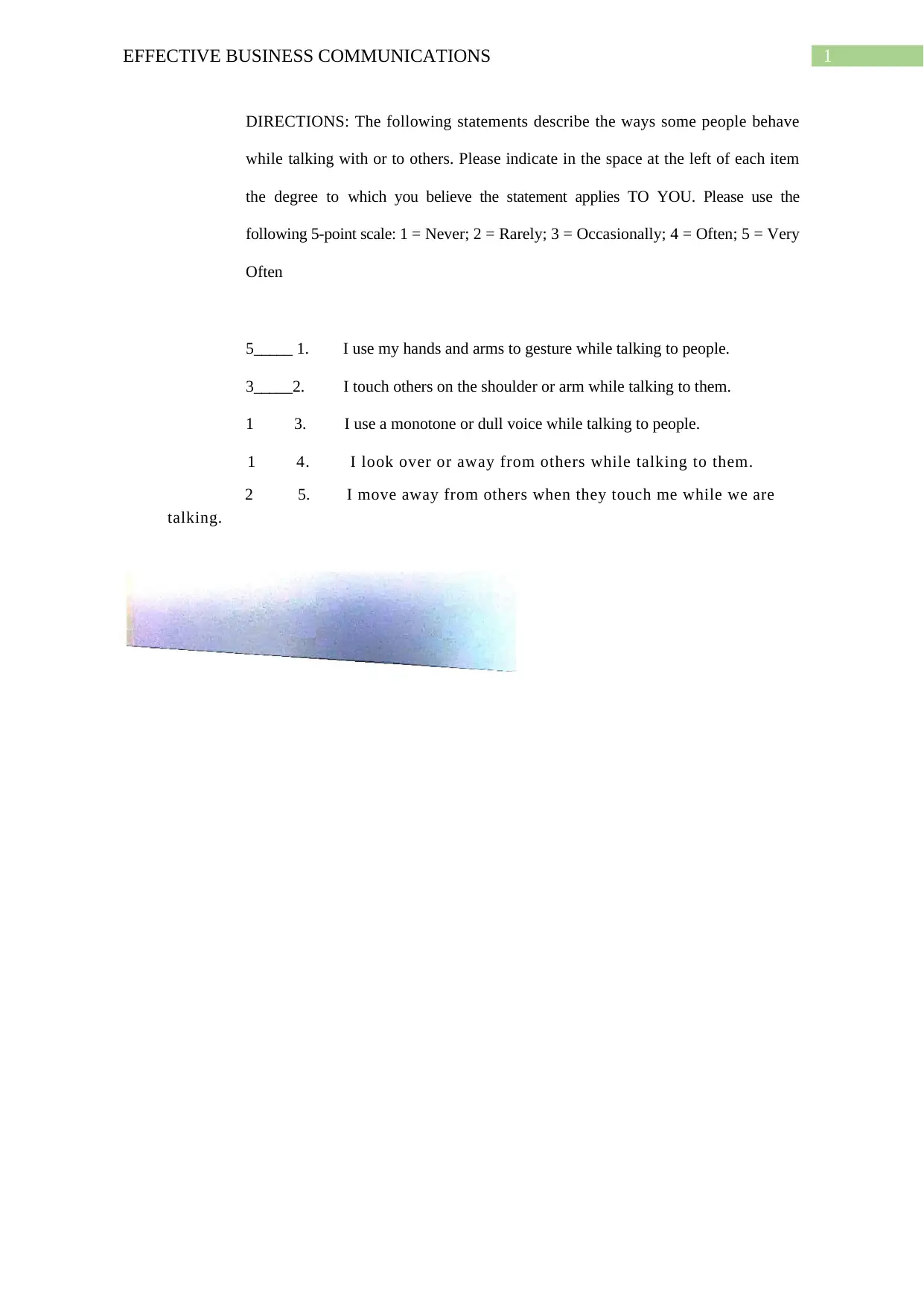
1EFFECTIVE BUSINESS COMMUNICATIONS
DIRECTIONS: The following statements describe the ways some people behave
while talking with or to others. Please indicate in the space at the left of each item
the degree to which you believe the statement applies TO YOU. Please use the
following 5-point scale: 1 = Never; 2 = Rarely; 3 = Occasionally; 4 = Often; 5 = Very
Often
5_____ 1. I use my hands and arms to gesture while talking to people.
3_____2. I touch others on the shoulder or arm while talking to them.
1 3. I use a monotone or dull voice while talking to people.
1 4. I look over or away from others while talking to them.
2 5. I move away from others when they touch me while we are
talking.
DIRECTIONS: The following statements describe the ways some people behave
while talking with or to others. Please indicate in the space at the left of each item
the degree to which you believe the statement applies TO YOU. Please use the
following 5-point scale: 1 = Never; 2 = Rarely; 3 = Occasionally; 4 = Often; 5 = Very
Often
5_____ 1. I use my hands and arms to gesture while talking to people.
3_____2. I touch others on the shoulder or arm while talking to them.
1 3. I use a monotone or dull voice while talking to people.
1 4. I look over or away from others while talking to them.
2 5. I move away from others when they touch me while we are
talking.
1 out of 31
Related Documents
Your All-in-One AI-Powered Toolkit for Academic Success.
+13062052269
info@desklib.com
Available 24*7 on WhatsApp / Email
![[object Object]](/_next/static/media/star-bottom.7253800d.svg)
Unlock your academic potential
© 2024 | Zucol Services PVT LTD | All rights reserved.





